2 DAY SKILLS PRACTICE INTENSIVE: WORKING WITH ANXIOUS MINDS AT SCHOOL AND AT HOME
WEDNESDAY, APRIL 19 - THURSDAY, APRIL 20, 2023 | RICHMOND, BC | 8:30 am - 4:00pm

WORKSHOP AGENDA
Day One
Interventions: Stress Management and Anxiety-Regulation Skills
School Recommendations, Medication, DSM-5® Classification, and Interventions for Separation Anxiety Disorder
Interventions for Generalized Anxiety and Panic Disorder
Day Two
Interventions for Social Anxiety Disorder and Selective Mutism
Interventions for Phobias and Stressor- and Trauma-Related Disorders
LEARNING OBJECTIVES
• Simulate the “Three Ingredients” framework to explain how anxiety develops in children and adolescents.
• Critique the role of family, schools, media, and global events in contributing to anxiety.
• Apply fun, engaging therapy activities to motivate your clients to change for each anxiety disorder.
• Apply a semi-structured child interview tips to develop targeted treatment plans.
• Verify four behavioral health recommendations to help all clients.
• Rate the pros and cons of prescription drugs and complementary medicine for anxiety.
• Assess how to manage ethical risks with families of divorce.
• Implement a three-step process for teaching stress management skills to young clients.
• Apply group therapy activities to reduce social anxiety.
• Detect the “Floating Technique” for panic anxiety.
• Produce exposure interventions to treat OCD, separation anxiety, social anxiety and phobias.
• Design anxiety reduction techniques to yourself to be a motivating role model.
Christine Dargon, Ph.D., having worked in clinical practice for over 20 years, now focusses her time on speaking and education. Dr. Dargon did graduate research and her dissertation on raperelated PTSD and began working with rape survivors over 25 years ago. Currently, Dr. Dargon is an international speaker traveling throughout North America presenting seminars of numerous topics. Dr. Dargon has also been teaching on the undergraduate and graduate levels for over 20 years and is currently on faculty at Grand Canyon University serving students in the Masters’ of Counseling Psychology Program and Ashford University teaching undergraduate courses. Dr. Dargon received her Doctorate of Counseling Psychology from Seton Hall University with a specialization in Marriage and Family Therapy. She recently opened a alternative health and wellness center in North Arizona.

WE ARE PLEASED TO WELCOME YOU TO A JACK HIROSE & ASSOCIATES WORKSHOP.


If you have any questions or concerns throughout the day, please notify your on-site coordinator.
PLEASE REMEMBER TO:
ü Wear your name badge every day
ü Turn off your cell phone
ü Hand in your evaluation forms at the end of each day
SCHEDULE:
This schedule may vary depending on the flow of the presentation and participant questions
8:00am – 8:30am Sign-In – Refreshments Provided
8:30am – 10:30am Workshop Begins
10:30am – 10:45am Mid-Morning Break – Refreshments Provided 10:45am – 12:00pm Workshop in Session
12:00pm – 1:00pm Lunch Break - Not Provided
Sign-In - CPA Members Only
1:00pm – 2:30pm Workshop in Session
2:30pm – 2:45pm Mid-Afternoon Break – Refreshments Provided
2:45pm – 4:00pm Workshop in Session
4:00pm Hand-In Evaluation Forms
Sign-Out – CPA Members Only
CERTIFICATES:
• Certifcates are available for all particpants to download.
• To download a copy of your receipt or certificate, please visit: http://registration.jackhirose.com/certificates
• Certificates will be made available to download once the workshop has ended.
Are you a member of the Canadian Psychological Association (CPA), Canadian Counselling and Psychotherapy Association (CCPA) or the Vocational Rehabilitation Association of Canada (VRA)?
Please read the important CEU information below.
• Please request a form from the on-site coordinator. Forms need to be filled out and submitted directly to the association by the participant.
• For CPA Members Only:
- New Policy as mandated by the Canadian Psychological Association
- CPA Members must take their name badge in the morning, sign in after lunch and sign out at the end of the day.
- Early departure means CPA Members are no longer eligible to receive CPA credits
- Certificates will be updated with CPA credits when the forms are returned to our head office for verification (please allow 2 – 4 weeks). Updated certificates are available for download here: http://registration.jackhirose.com/certificates
Anxiety Disorders in Children and Adolescents:
WELCOME!!!
Recognizing and Treating the Emerging Epidemic
Dr. Christine Dargon603-321-7284 docborg98@yahoo.com
On Linkedin and Facebook:
Dr. Christine Frydenborg Dargon www.christinefrydenborgdargon.comMaterials that are included in this course may include interventions and modalities that are beyond the authorized practice of mental health professionals. As a licensed professional, you are responsible for reviewing the scope of practice, including activities that are defined in law as beyond the boundaries of practice in accordance with and in compliance with your professions standards.
• Anxiety and depression affect many children
• 9.4% of children aged 3-17 years (approximately 5.8 million) had diagnosed anxiety in 2016-2019.
4.4% of children aged 3-17 years (approximately 2.7 million) have diagnosed depression in 2016-2019.
• Anxiety and depression have increased over time

• “Ever having been diagnosed with either anxiety or depression” among children aged 6-17 years increased from 5.4% in 2003 to 8% in 2007 and to 8.4% in 2011–2012.
• “Ever having been diagnosed with anxiety” among children aged 6- 17 years increased from 5.5% in 2007 to 6.4% in 2011–2012.
• “Ever having been diagnosed with depression” among children aged 6-17 years did not change between 2007 (4.7%) and 2011–2012 (4.9%).
(Statistics from the CDC USA)
Anxiety Continuum
• According to JAMA Pediatrics, even before the pandemic, the rate of child and adolescent anxiety increased 27% between 2016 and 2019. By 2020, more than 5.6 million youths were diagnosed with anxiety. With symptoms such as trouble concentrating, an upset stomach, or sleeplessness, anxiety can be one of the most debilitating challenges students face in classrooms today.
No
When children do not outgrow the fears and worries that are typical in young children, or when there are so many fears and worries that they interfere with school, home, or play activities, the child may be diagnosed with an anxiety disorder. Examples of different types of anxiety disorders include
• Being very afraid when away from parents (separation anxiety)
• Having extreme fear about a specific thing or situation, such as dogs, insects, or going to the doctor (phobias)
• Being very afraid of school and other places where there are people (social anxiety)
• Being very worried about the future and about bad things happening (general anxiety)
• Having repeated episodes of sudden, unexpected, intense fear that come with symptoms like heart pounding, having trouble breathing, or feeling dizzy, shaky, or sweaty (panic disorder)
Anxiety may present as fear or worry, but can also make children irritable and angry. Anxiety symptoms can also include trouble sleeping, as well as physical symptoms like fatigue, headaches, or stomachaches. Some anxious children keep their worries to themselves and, thus, the symptoms can be missed.
https://www.youtube.com/watch?v=WuyPuH9ojCE
• What types of anxiety are common in children?
• Separation anxiety: Very anxious and upset when parted from parents and caregivers; refusal to attend camp, sleepovers, or play dates; worry that bad things will happen to self or loved ones while separated.
• Social anxiety: Strong fear of social situations; very anxious and self-conscious around others; worry about being judged or humiliated.
• Specific phobia: Severe, irrational fear set off by a situation or thing, such as thunderstorms, worry about vomiting, or insects.
What makes some children more vulnerable to anxiety?
• Anxiety may set deep roots due to a blend of
• biological factors, such as genes and brain wiring
• psychological factors, such as temperament and coping strategies
• environmental factors, such as anxious parenting or troubling early childhood experiences and environment.
Cognitive Theory of Anxiety
Environment
• Environment is key:
• Health issues
• Major life changes
• Break up/divorce
• Death of family member of close friend
• Seen/been involved in a crime/accident
• Health or drug issue of a family member
• Had the individual been exposed to a traumatic event?
• Direct experience
• Threat or perceived threat to life or body
• Witness an event that involves this aspects with another person
• Re-experience a traumatic event
• Has there been a catastrophe or disaster?
Behavioral – learned anxiety
• Fear and worry can be learned (children):
• Are the parents anxious?
• What goes on in the home?
• What is the child being exposed to?
• How do parents interact with one another?
• Arguing?
Behavioral Factors and Children
• Violence on tv and video games


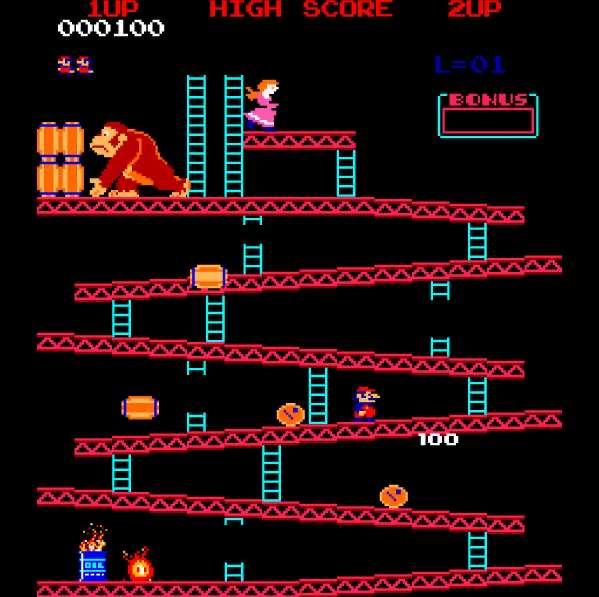
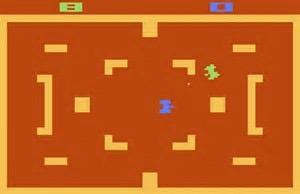


• http://www.screenagersmovie.com/



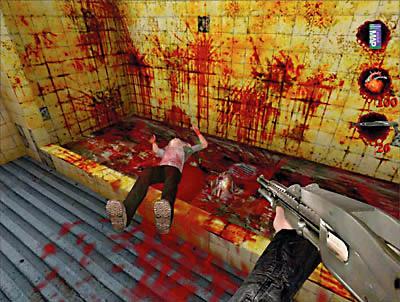



• Bullying in/out of school
• 13 Reasons Why – Netflix
• What is online? Youtube; Blue Whale Challenge: “This Web Site provides peer-support only. I understand that I will not receive psychological, medical, or legal advice through my use of this website. I agree that I will not use this Web Site as a substitute for professional services.”
“The Blue Whale Game (Russian: Синий кит, translit. Siniy kit), also known as "Blue Whale Challenge", is a 21st-century social network phenomenon that is claimed to exist in several countries, beginning in 2016. The game reportedly consists of a series of tasks assigned to players by administrators over a 50-day period, with the final challenge requiring the player to commit suicide [1][2]
"Blue Whale" came to prominence in May 2016 through an article in Russian newspaper, Novaya Gazeta, that linked many unrelated child suicides to membership of group "F57" on the VKontakte social network. A wave of moral panic swept Russia.[3] However the piece was later criticised for attempting to make a causal link where none existed, and none of the suicides was found to be as a result of the group activities”
Think of all possible areas and sources!!!
Behavioral – Learning Theories
• “Because the neural circuitry for fear learning is located in the amygdala, and because it is likely that exposure changes neural pathways in the hippocampus, fear learning is not “undone” by exposure. Patients learn something new about the fear. Therefore, this new learning must occur frequently and in many different contexts. Exposure must be repeated to consolidate learning and make the working memory that the feared stimulus is “safe” automatic” (Sudak, 2011, pg. 106).
Cognitive Behavioral
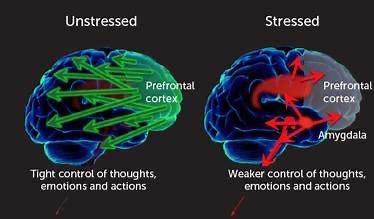
• It is easy for a client to generalize their anxiety once they start to become anxious over any one thing.
• “Patients can become chronically anxious or worried about future occurrences of anxiety. Frequently, they struggle with symptoms that are generated just by thinking of anxiety-provoking stimuli. Patients can become fearful about situations that “seem” connected to the anxiety” (Sudak, 2011, pg. 106).
• Panic is about fear of more panic.
Physiology
• There is much evidence to show that anxiety disorders and phobias run in families (Muris, 2008).
• Twin studies also have provided much evidence that there is a strong genetic component to anxiety (Stevenson, Batten & Cherner, 1992; Rose & Ditto, 1983).
• “Neural circuits responsible for conscious self-control are highly vulnerable to even mild stress. When they shut down, primal impulses go unchecked and mental paralysis set in.”
• Arnsten, A., Mazure, C. M., & Simha, R. (2012). This is Your Brain in Meltdown. Scientific American, April, 2012, 48-53.
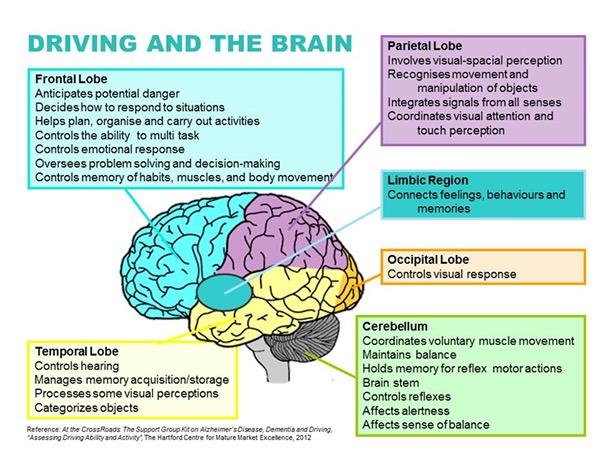
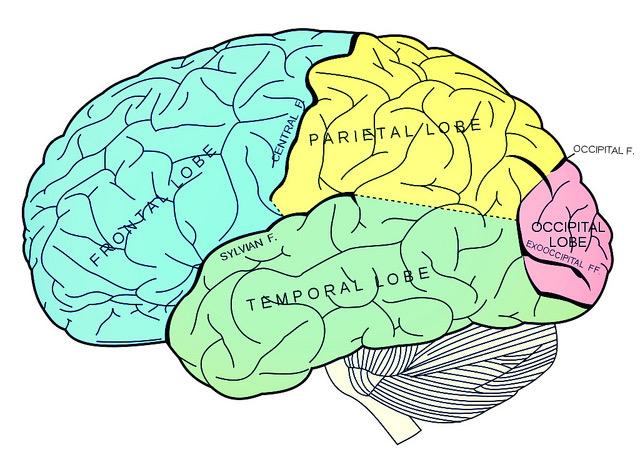
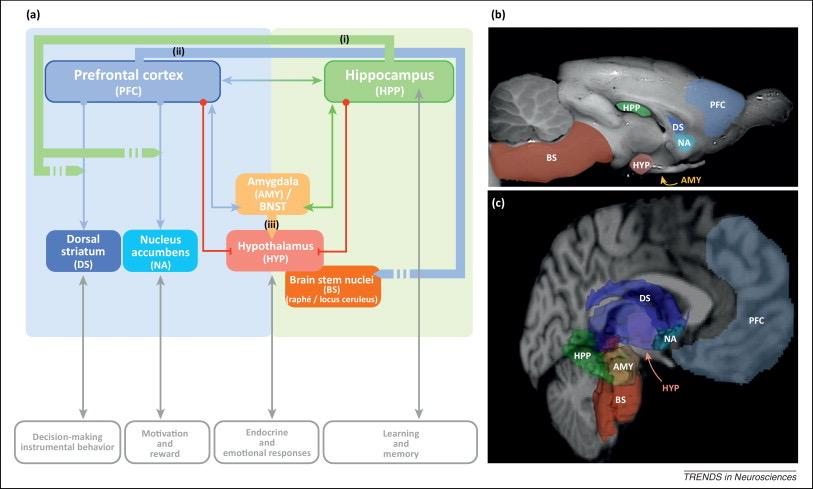
• Anxiety is intimately tied to the physiology of the body.
• Perceived danger triggers the flight or fight response.
• Heart beats faster – need to get blood to the parts of the body required to act (rapid heart beat)
• Breathe increases to circulate more oxygen (numbness, tingling, light headed)
• We sweat more (palms, head etc..)
• Pupils dilate (vision may blur)
• Salivation decreases (dry mouth)
• Muscles tense up to prepare for action (muscle aches, tension or trembling)
• (Pincus, et al., 2008)
Why do we lose it?
• The main executive control center of the brain is just behind the forehead = the prefrontal cortex.
• Controls impulses and manages inappropriate ones
• Undermined even by basic daily stressors
• Interferes with our ability to control such impulses
• Emotions and impulsivity take over.
“This is Your Brain in Meltdown”
Amygdala
• Controls production of dopamine and norepinephrine when under stress.
• Such increased production tells the prefrontal cortex, essentially, to shut down
• Strengthens activity in the striatum and amygdala
• High levels of dopamine and norepinephrine in the prefrontal cortex switches on receptors that open channels causing the disconnection of prefrontal neurons weakening our ability to control our emotions and impulses.

Your Brain
• Unstressed:
• The pre-frontal cortex regulates:
Hunger
• Sex
• Aggression
Emotional responses such as fear
• Stress responses from the brain stem
• Neurons including norepinephrine and dopamine
• Stressed:
• Amygdala commands the increased production of norepinephrine and dopamine
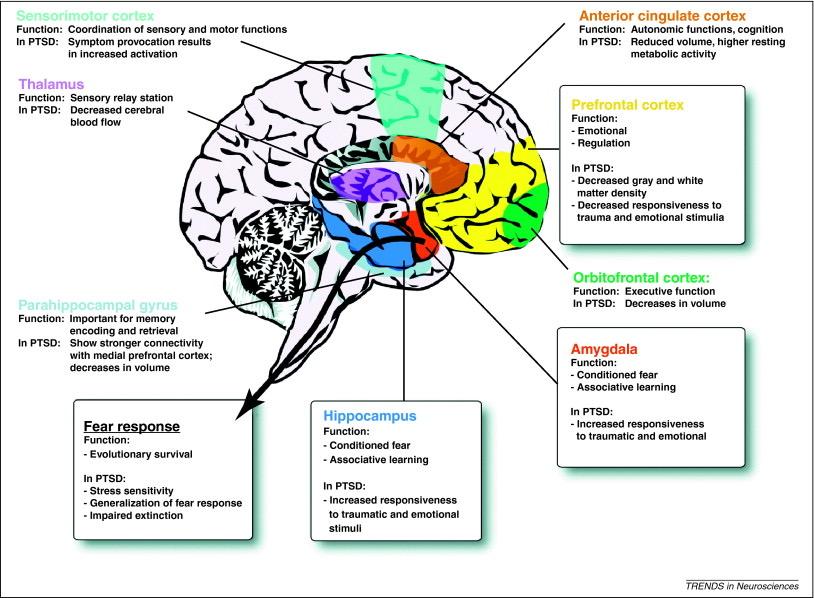
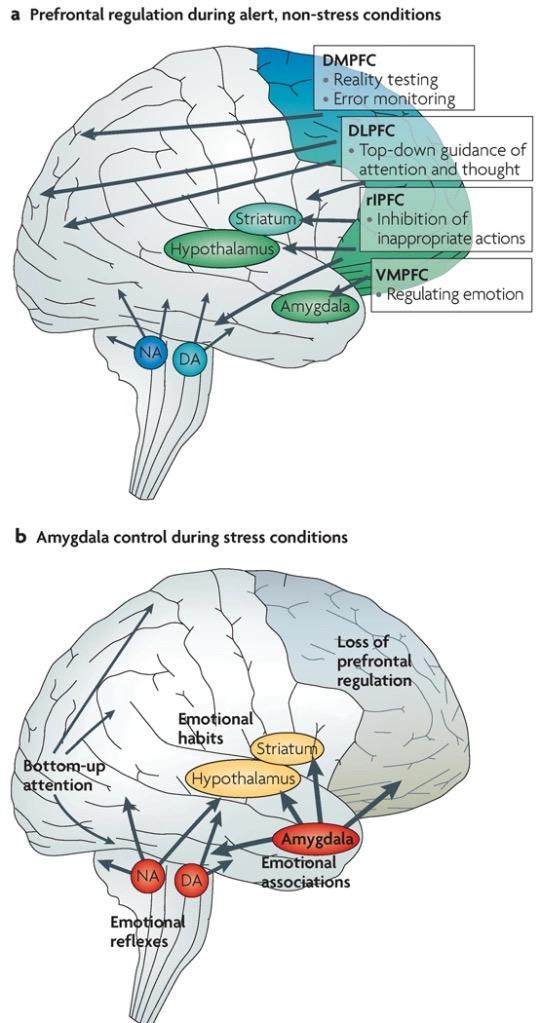
• Shuts down the pre-frontal cortex This weakens the pre-frontal cortex’s role in controlling emotions and impulses.

Development
• As we grow up our ability to worry and be anxious increases as our brain develops cognitively.

• As we are able to think more abstractly and in a more detailed fashion than we are able to worry more and even panic. That is why panic is unusual in children (Muris, 2008).
Psychosocial
• Although there is much research to indicate that anxiety runs in families, there are two components to this:
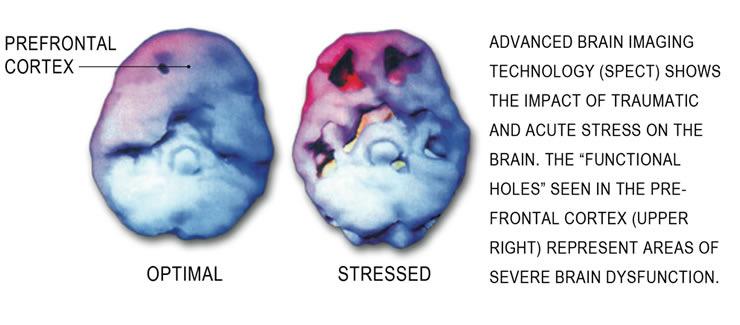
• There is evidence that there is a genetic component but also that often fears are learned.

• We learn fear from:
• Direct experience (being bitten by a dog)
• Observations (see parent anxious when driving)
• Hearing or reading about situations (seeing the media coverage of an airplane crash)
(Anthony, M. M. & Swinson, R. P., 2000)
Anxiety Disorders
• Generalized Anxiety Disorder
• Phobias
• Social Anxiety (Social Phobia)
• Separation Anxiety
• Selective Mutism
• Panic Disorder/Panic Attacks
• Agoraphobia
• Generalized Anxiety Disorder
• If your child has generalized anxiety disorder, or GAD, he or she will worry excessively about a variety of things such as grades, family issues, relationships with peers, and performance in sports.
• Children with GAD tend to be very hard on themselves and strive for perfection. They may also seek constant approval or reassurance from others.
• Separation Anxiety Disorder
• Many children experience separation anxiety between 18 months and three years old, when it is normal to feel some anxiety when a parent leaves the room or goes out of sight. Usually children can be distracted from these feelings.
It’s also common for your child to cry when first being left at daycare or pre-school, and crying usually subsides after becoming engaged in the new environment.
• If your child is slightly older and unable to leave you or another family member, or takes longer to calm down after you leave than other children, then the problem could be separation anxiety disorder, which affects 4 percent of children. This disorder is most common in kids ages seven to nine. When separation anxiety disorder occurs, a child experiences excessive anxiety away from home or when separated from parents or caregivers. Extreme homesickness and feelings of misery at not being with loved ones are common.
• Other symptoms include refusing to go to school, camp, or a sleepover, and demanding that someone stay with them at bedtime. Children with separation anxiety commonly worry about bad things happening to their parents or caregivers or may have a vague sense of something terrible occurring while they are apart.
• Social Anxiety Disorder
• Social anxiety disorder, or social phobia, is characterized by an intense fear of social and performance situations and activities such as being called on in class or starting a conversation with a peer.
• This can significantly impair your child’s school performance and attendance, as well as his or her ability to socialize with peers and develop and maintain relationships.
• Selective Mutism
• Children who refuse to speak in situations where talking is expected or necessary, to the extent that their refusal interferes with school and making friends, may suffer from selective mutism.
• Children suffering from selective mutism may stand motionless and expressionless, turn their heads, chew or twirl hair, avoid eye contact, or withdraw into a corner to avoid talking.
• These children can be very talkative and display normal behaviors at home or in another place where they feel comfortable. Parents are sometimes surprised to learn from a teacher that their child refuses to speak at school.
• The average age of diagnosis is around 5 years old, or around the time a child enters school.
• Specific Phobias
• A specific phobia is the intense, irrational fear of a specific object, such as a dog, or a situation, such as flying. Common childhood phobias include animals, storms, heights, water, blood, the dark, and medical procedures.
• Children will avoid situations or things that they fear, or endure them with anxious feelings, which can manifest as crying, tantrums, clinging, avoidance, headaches, and stomachaches. Unlike adults, they do not usually recognize that their fear is irrational.
• Panic Disorder
• Panic disorder is diagnosed if your child suffers at least two unexpected panic or anxiety attacks which means they come on suddenly and for no reason followed by at least one month of concern over having another attack, losing control, or "going crazy."
Symptoms of Panic Attacks
Palpitations, Pounding heart, or accelerated heart rate
Sensations of shortness of breath or smothering
Feeling dizzy, unsteady, light headed or faint
Chills or hot flashes
Sweating
Feeling of choking
Chest pains
Nausea
Trembling or shaking
Fear of Losing control
Fear of Dying
Numbness or tingling
Phobias (Specific)
• The focus is a specific object or situation.
• The person experienced extreme fear that continues and is excessive or irrational in response to the object or situation.
• If the person encounters the object or situation, they experience anxiety. In children this may be exhibited with tantrums, crying, freezing or clinging.
• The object or situation is avoided.
• The fear and avoidance interferes with the client’s normal routine, relationships, or social activities
• The fear causes marked distress and is out of proportion
Panic Disorder
• There is much evidence indicating that, if left untreated, the symptoms of Panic Disorder, when arising in adolescents, may become chronic and persist throughout adulthood (Keller et al., 1994; Biederman et al., 1997; Wittchen, Reed, and Kessler, 1998; Yonkers et al., 1998).
• In order to be diagnosed with Panic Disorder, the person needs to experience reoccurring panic attacks
• The attacks are followed by at least one month of chronic worry that another will occur
• You must make sure that the attacks are not being cause by drug usage or a medical condition
Separation Anxiety
• A Disorder of Infancy, Childhood or Adolescence
• Excessive anxiety and worry about being separated from home or attachment figures as seen by three of the following:
• Recurrent excessive distress in anticipation of separation
• Persistent and excessive worry about losing attachment figure
• Persistent and excessive worry about untoward event causing separation
• Reluctance or refusal to go out, away from home, to school, to work
• Persistent and excessive fear of or reluctance to be alone
• Reluctance or refusal to sleep away
• Nightmares of involving theme of separation
• Complaints of physical symptoms
• At least 4 weeks in children, 6 months in adults
Social Anxiety/Phobia
• This is a significant fear of a social situation or situation in which a person would have to perform.
• The person fears humiliation.
• With children the fear must occur with peers as well as adults.
• Exposure to the situation causes a heightened level of anxiety.
• In children this may be exhibited with tantrums, crying, freezing or clinging.
• The situation is avoided or endured with intense anxiety.
• The fear and avoidance interferes with the client’s normal routine, relationships, or social activities
• The fear causes marked distress
• Lasts more than 6 months
Selective Mutism
• New to the DSM-5 under Anxiety Disorders
• Consistent failure to speak in which there is the expectation
• Interferes with school or work
• Lasts at least 1 month
• Not attributed to a lack of knowledge
• Not a communication disorders or due to another disorder such as autism or schizophrenia
• Commonly occurs along with Social Anxiety Disorder or others
Anxiety Disorders due to Medical Conditions
• Anxiety or panic attacks predominant
• Evidence (history, physical exam, lad work etc..) that there is a physiological cause
• Such a endocrine conditions (hyper and hypothyroidism, hypoglycemia, etc..), cardiovascular (congestive heart failure, etc..), respiratory conditions (pneumonia, COPD, etc..), metabolic conditions (vitamin B12 deficiency, etc..) and neurological conditions (neoplasms, etc..)
• The symptoms are not better explained by another mental disorder such as Adjustment Disorder with Anxiety in which the stressor is a medical condition.
• The symptoms are not occurring during an episode of delirium.
• The issue causes distress and/or impairment in work, relationships etc..
Substance/Medication Induced Anxiety Disorder
• Anxiety or Panic Attacks are dominant.
• There is evidence (history, labs, physical exam etc..) of one of the following:
• Symptoms developed during or within 1 month of Substance Intoxication (alcohol, amphetamine, caffeine, cannabis, cocaine, hallucinogens, inhalants, etc..) or Withdrawal (alcohol, cocaine, sedatives, hypnotics, anxiolytics, etc..)
• Medication use is etiologically (evidence) related to the disturbance.
• The symptoms are not better attributed to another anxiety disorder.
• Symptoms do not occur during an episode of delirium.
• Causes impairment in work, relationships etc..
• The anxiety is more excessive then you would expect.
• Specify the substance.
• Obsessive-compulsive disorder (OCD) and posttraumatic stress disorder (PTSD) are closely related to anxiety disorders, which some may experience at the same time, along with depression.
• Obsessive-Compulsive Disorder (OCD)
• OCD is characterized by unwanted and intrusive thoughts (obsessions) and feeling compelled to repeatedly perform rituals and routines (compulsions) to try and ease anxiety. Learn more about OCD
• Most children with OCD are diagnosed around age 10, although the disorder can strike children as young as two or three. Boys are more likely to develop OCD before puberty, while girls tend to develop it during adolescence.
Obsessive-Compulsive Disorder
• No longer under Anxiety – differentiate by real or imagined
• A person can have obsessions (thoughts) or compulsions (behaviors).
• Thoughts are not just excessive worry. They can not be ignored even though the client attempts to do so.
• The thoughts are the product of the client’s own mind and they can recognize that.
• Compulsions involve repetitive behaviors or mental acts (praying, counting etc..). The person feels that they must do these acts because of obsessive thoughts that they are experiencing.
• The purpose of the behaviors is to reduce or eliminate distress, something bad from happening
• The behaviors do not have a realistic connection to the feared outcome
OCD (cont.)
• The client is able to recognize that the thoughts and/or behaviors are irrational, excessive or unrealistic is no longer required
• The thoughts and/or behaviors cause a great deal of distress and usually take up a great deal of time. They may also cause significant interference in the client’s normal daily routine, work or other activities.
• Be careful to differential diagnosis such as an obsession with food actually be indicative of an Eating Disorder.
Forms of OCD Compulsions – relieve the anxiety
• There are common groups of OCD: anxiety over harm coming to the client or the client causing harm to someone else.
• According to Penzel (2000), he has created 8 subcategories:
• Morbid Obsessions About Sex (aggressions or taboo)
• Contamination (germs and hand washing)
• Religious (God disliking, breaking rules)
• Harm, Danger, Loss or Embarrassment
• Superstitious of Magical (numbers, words)
• Body Focused (body functions, eating disorders
Perfectionistic (to prevent consequences, know everything, do something perfectly)
• Neutral (unimportant things, objects – no consequences. Anxious because cannot control or make stop)
Decontamination
Diseases, germs
• Hand washing
• Checking
• Repeated – fear consequences
Physical and/or mental
• Magical/Undoing
Not logical and no connection
• Perfectionistic
• Control doubt
Decision making is hard
• Counting Urge, control, connected to magical sometimes
• Posttraumatic Stress Disorder (PTSD)
• Children with posttraumatic stress disorder, or PTSD, may have intense fear and anxiety, become emotionally numb or easily irritable, or avoid places, people, or activities after experiencing or witnessing a traumatic or life-threatening event.
• Not every child who experiences or hears about a traumatic event will develop PTSD. It is normal to be fearful, sad, or apprehensive after such events, and many children will recover from these feelings in a short time.
• Children most at risk for PTSD are those who directly witnessed a traumatic event, who suffered directly (such as injury or the death of a parent), had mental health problems before the event, and who lack a strong support network. Violence at home also increases a child’s risk of developing PTSD after a traumatic event.
PTSD
• Avoidance of stimuli associated with the event
• Alterations in cognition and mood as seen in two of the following:
• such as unable to remember, negative beliefs, distorted thoughts (self blame), negative emotions (fear, anger guilt, shame), diminished interest, detachment, inability to experience positive emotions
• Alterations in arousal and reactivity as seen in two of the following:
• Irritable or angry outbursts, reckless or self-destructive, hyper vigilant, exaggerated startle response, difficulty concentrating, trouble sleeping
• Lasts more than a month
• Causes marked distress
• Touching/Movement
Magical – touch certain things/move certain way
• Self-Mutilate
Cutting, scratching
• Relief, control
• Body-Focused Control over body
• Grooming Self-soothing, control
• Mental – obsessive thoughts
• Avoid harm, undue harm
Distraction
• Protective Avoid harm – keep asking others if ok.
Post-Traumatic Stress Disorder
• Now a distinct classification in the DSM-5
• In children over 6, teens and adults:
• Exposure to actual or threatened death, serious injury, sexual violence by either experiencing it, witnessing, learning that it occurred or repeated exposure such as a first responder.
• Experience intrusion symptoms:
• Memories, dreams, flashbacks, psychological distress, marked reaction to cues
For Children, reenactment in play
PTSD Children 6 or under
• Children may reenact in their play
• Difficult to ascertain the content of the dreams
• Avoidance of places or people that represent that event
• May see constriction of play
• Socially withdrawn
Acute Stress Disorder
• Very similar to PTSD except:
• Duration is 3 days to 1 month (in the DSM-IV it was 2 days)
• So you may diagnose Acute Stress and than once you reach the 1 month mark the diagnosis will be changed to PTSD.
Trichotillomania and Excoriation
• No longer under Anxiety Disorders – more common though in children and teens than realized. More common in females
• Recurrent causing hair loss/lesions
• Repeated attempts to stop
• Causes marked distress
• Not attributable to another medical condition/drug use
Co-morbidity Confusion
• Patients with anxiety disorders are at risk for multiple types of anxiety. For example, patients with panic disorder have an increased risk of agoraphobia. Patients with anxiety disorders have a higher risk of depression, with a lifetime prevalence of 50 to 60% in patients who have panic disorder (Kessler et al., 1998). Patients with anxiety and co-morbid depression are at a higher risk for suicide attempts and completion (Weissman, Klerman, Markowitz, & Ovelette, 1989) than patients with either condition alone. Substance misuse and dependence are frequent, perhaps because patients use them to obtain relief from symptoms or because of a genetic predisposition for both conditions. Co-morbid conditions make treatment more complicated (Sudak, 2011).
• Often mistaken for:
• ADHD
• Depression
• Learning disabilities
Are you and eagle or a chicken?
• Anxiety and ADHD, at times, often look very much like each other, and it takes a discerning eye to figure out which one it is. And, to complicate things further, sometimes there can be a little bit of both.
Infancy Stranger Anxiety develops around 7-9 months and typically ends by age 1.
Early Childhood Separation anxiety develops around age 1 and usually ends sometime over the next three years, before Kindergarten. Children will often fear new things and situations. Perceived dangers may be real or imagined.
Elementary School Children begin to fear “real-world dangers” such as fire, storms, burglars etc.. Learn that these can be “remote rather than imminent dangers”.
Middle School Social comparisons and worries about social acceptance. May also worry about grade, sports, friends and social status.
High School Focus remains on social life. Focus now is on finding the right group. There may be concerns about the world, moral issues and/or their future.
Identifying Signs Of Anxiety In Children
• Does your child have any of these symptoms?
• Agitation
• Restlessness
• Inattention, poor focus
• Somatic symptoms like headaches or stomachaches
Avoidance

• Tantrums
• Crying
• Refusing to go to school
• Meltdowns before school about clothing, hair, shoes, socks
• Meltdowns after school about homework
• Difficulties with transitions within school, and between school and an activity/sport
• Difficulty settling down for bed
• Having high expectations for school work, homework and sports performance
Anticipatory Thoughts
• We often cross bridges
• How likely are we to come to that bridge?
• Are we being realistic in our expectations?
• Are we exaggerating the possible outcomes?
• PROBABILITY!!!
• What are the chances of that really happening?
• Which is more likely – that or the lottery?
• Essentially, anxiety in children tends to manifest as negative behaviors that you may have glimpsed briefly in the past but are becoming noticeable, consistent and intense. Over time, these behaviors can become frustrating to parents who feel unable to handle these newly arising attitudes, and don't know how to deal with children that are not responding to punishment, yelling, or to any other methods that were once effective.
• Delays in self-regulation skills are all too often mistaken by others as a “behavior problem.”
• If we’re honest with ourselves, we all become overwhelmed by the stressors of life, the hurdles we encounter, and the flood of emotions that come with this.
• Consider a student who naturally doesn’t have the resilience of an adult, but also does not have the developmental skill set like his peers to cope and manage internal or external conflicts during the countless trying circumstances he encounters throughout his everyday routines and activities.
• Lacking awareness of his feelings and how to regulate them in the social context, his delays in self-regulation skills are all too often mistaken by others as a “behavior problem.”
Catastrophic Thinking
• The worst thing possible is going to happen!
• Is that event really likely to happen?
• If it were, what is the most likely outcome?
• What are the chances of your predicted outcome occurring?
• What would you do?
• What are the chances of this actually occurring?
• If I lose my train of thought during my presentation, I am going to fail!
Decatastrophizing
• 1. Either in session or at home, talk about the triggering situation.
• 2. Explore the anxious thoughts and predictions? What does the client believe is going to happen – worst case scenario?
• 3. What if my thoughts come true? What will happen? What will you do to handle it?
• 4. What are the chances of that really happen? Are you more likely to experience that or win the lottery?
Common Thoughts that Contribute to Anxiety:
Mind Reading: Knowing what other people are thinking
Probability Overestimations:
• A prediction you believe it likely to come true
• Likelihood actually low
• Everyone will think I am stupid
• I will never find anyone again (relationship)
(Anthony & Swinson, 2000)
Common Thoughts (cont.)
• Personalization:
• Taking responsibility for negative things occurring in a situation.
• Not taking into consideration all of the other possible factors
• Boss gets angry with you. You assume it is because he does not like you or thinks that you are incompetent. In reality, you neglect to consider he is having a bad day, he yells at other people too and often, his expectations are too high etc..
(Anthony & Swinson, 2000)
Common Thoughts (cont.)
• Should Statements:
• Shoulds are incorrect, inaccurate and exaggerations.
• Similar statements are ones that include always, never, should and must.
• Could be a sign of rigidity, expectations being too high, perfectionist etc..
• I should never feel nervous
• I should never get less than an A
• I should never make a mistake
(Anthony & Swinson, 2000)
Common Thoughts (cont.)
• Negative Core Beliefs:
• Deep and long standing assumptions
• Contribute to our emotions, self-esteem etc..
• Negative beliefs about the self
• The more strongly believes than the harder they are to change
• In order to get at a client’s core beliefs, is by “continually asking about the meaning of each fearful belief you have until the core beliefs underlying your anxious interpretations are revealed”
(Anthony and Swinson, pg. 110, 2000).
How to identify Anxious Thoughts
• Ask the client or have them ask themselves questions such as:
• What are you afraid will happen?
• What will people think of you?
• Do you worry about what other people will think?
• It that something that is very important to you?
• What are you expectations?
• What if those expectations come true or not?
The Floating Technique
Cognitive Restructuring
• We are going to restructure or change the current thoughts that the client is happening:
• Thoughts are not facts but opinions
• What evidence is there to support that this thought is true?
• What evidence is there to support that this thought is false?
• Explore other conclusion or opinions about the initial trigger to the initial thought.
• Practice, practice, practice
The Floating Technique

• By Dr.
Paul Foxman• Practice Opportunities
• Face – Don’t avoid your anxiety
• Accept – practice opportunities
• Float – relax through it
• Let time pass – it will pass
• Deep Relaxation exercises
• Tensing muscles and then releasing
• Deep breathing – diaphragmatic breathing

• Removing safe behaviors:
• Safe behaviors are the things that the client has done in order to reduce their anxiety. Usually these are avoidant behaviors and can be minor such as distracting oneself or major such as using drugs or alcohol
• They keep the client from having to truly deal with their anxiety
• The client must face the anxiety to overcome it
Deep breathing
• Lie down, bend knees and have feet shoulder width apart.
• Scan your body and identify the places that are tense.
• Place one hand on your stomach and one on your chest.
• Inhale slowly, through nose – feel hand on stomach move but not chest.
• Exhale through mouth
• Repeat at least five times prolonging exhale.
• Scan body again so evaluate tension.
Progressive Muscle Relaxation
• Engage in deep breathing but you can do this sitting down, standing or lying down.
• Tense parts of the body either individually or in groups. Hold the tension for 5-7 seconds and then relax:
• Hands, arms
Head, face, throat and shoulders
• Chest, stomach, lower back
• Buttocks, thighs, calves and feet
• If it helps, tell yourself: “relax”, “Let it go”, “let go”, “it’s ok” etc..
In depth Progressive Relaxation
• Get detailed and in depth:
• Start with wrinkling your forehead
• Squint your eyes
• Open mouth wide
• Clench jaw
• Make fists
• Arch back
• Push heels into surface
• Curl toes
• Get detailed and even record it so you can do each step by step.
• You can also do all of these at once for a quick relief.
Habit Reversal Training (HRT)
• Developed for specific types of OCD such as skin picking, nail biting etc.. Can be useful for OCD in children:
• Step 1:Develop an awareness
• Often not at all aware even doing it
• Step 2:Learn Relaxation Skills
• Reduce tension/worry
• Step 3:Diaphragmatic Breathing
Learn to regulate own breath and reduce anxiety
• Step 4:Muscle Tensing
• Make fists, tense arms, press elbows into sides
• If you do this you can not nail bite or pull hair
Quick alternative – pull down into chair
Mindfulness
• “Paying attention with flexibility, openness and curiosity” (Harris, 2009).
• It is an awareness process and not about thinking. Paying attention to an experience rather then focusing on thoughts.
• Be open and curious.
• Being able to control your focus and direct it towards different aspects of your experience.
Rewards and Children
• Working with children can be very challenging – you can not make them face something that feels bad
• Reward them with therapy compliant behaviors.
• No reward or payoff for non therapy related behaviors
• HOWEVER, in session and at home you do not want any negative consequences or punishment – do not associate negatives with treatment.
• Still use parent(s) as coach.
Mindfulness Exercise
• There are many varieties but all have the same key components to them:
• Notice something – pick the thing you want to focus your attention on. This is about noticing your experience.
• Let go of your thoughts
• Let your feelings be
Mindfulness exercises
• One Minute Breathing
• This exercise can be done anywhere at any time, standing up or sitting down. All you have to do is focus on your breath for just one minute. Start by breathing in and out slowly, holding your breath for a count of six once you’ve inhaled. Then breathe out slowly, letting the breath flow effortlessly out back into the atmosphere.
Mindful Observation
• Pick a natural organism within your immediate environment and focus on watching it for a minute or two. This could be a flower or an insect, the clouds or the moon. Don’t do anything except notice the thing you are looking at. But really notice it. Look at it as if you are seeing it for the first time.
• Touch Points
• Think of something that happens every day more than once, something you take for granted, like opening a door for example. At the very moment you touch the door knob to open the door, allow yourself to be completely mindful of where you are, how you feel and what you are doing.
• http://www.pocketmindfulness.com/6-mindfulness-exercises-you-can-try-today/
Jedi Mindfulness
• 1. Define the “Force”
• In the Star Wars’ movies, it becomes clear very quickly that the Force is an awesome power that everyone wants. But what exactly is the Force? When I work with kids, I provide them with my interpretation. The Force is the power we get from any emotion whether it comes from the light side or the dark side. From love, joy, and surprise to anger, sadness, and worry, nothing is “good” or “bad.” These emotions are only messengers, and all are part of the Force.
• Very plainly, The Force = The Power of Emotions
• Try this: Ask your child if he or she would like to go through Jedi training. Tell your son or daughter that their mission will be to decode the secret messages being sent by the Force (e.g., their worried thoughts, their angry feelings).

• 2. Wave Hello to the Dark Side
• If your child feels anxious, the way around the discomfort is straight through it. We must teach our children not to deny, avoid, or squash parts of their emotional experience. Long-term avoidance of emotions can actually spark and perpetuate depression, anxiety, and substance abuse. When we choose not to face our worry, we are left much like Darth Vader, enslaved by our pain.
• The alternative to avoidance is acknowledgement. I understand helping your child acknowledge his or her anxious feelings instead of shutting them down is not an easy choice. Sometimes it’s easier to just say, “Don’t worry so much. Please trust me, it’ll be fine.”
• As a parent myself, I completely understand this path. Sometimes we don’t have the emotional bandwidth to support a child’s chronic worry, especially when it seems our love and reassurance are not having a positive effect. Anxious emotions are often big emotions that can be uncomfortable for the entire family.
• All that said, when you parent an anxious child, you seek one thing above almost anything else for your child: inner peace. Toward this goal, acknowledgement is the stepping stone.
• Try this: Next time your children worry, tell them they are Jedi Knight and Jedis acknowledge the Force (an emotion) when they feel it. They can wave hello to their worry and say, “Hey, worry. I see you’re back. I’m a Jedi. I understand you’re trying to tell me something.”
• 3. Lean into the Dark Side
• Leaning into the dark side takes training because, at first, it can feel messy and uncomfortable. Leaning in means allowing your child the space to physically feel where the Force or worry is flowing on the inside. Allowing discomfort to pass gets us a step closer to decoding the message from our emotion. Anxiety activates the sympathetic nervous system, and as such, feelings of worry are often felt in such places as the stomach, chest, and throat. Breathing with visualization can calm the nervous system and begin to kick a child’s logical brain back into gear.
• Try this: Obi-Wan instructs Luke to close his eyes and, “Stretch out with your feelings”; Yoda says, “Allow the force to flow through you.” When your son or daughter worries, have them close their eyes and ask them where they are feeling the worry or the Force flowing inside of their body. Now, ask your children to breathe into the place in their body where they feel the Force. While they take a deep breath, ask them to imagine what the Force actually looks like. What color is it? What consistency is it? Maybe it looks like a dark cloud. Once they have the visual, ask them to breathe the Force out. To support your child during this process, you can use phrases like, “I am here, and you are completely safe, my young Jedi. This feeling will pass.”
• 4. Put the Light Saber Down
Our range of feelings (light and dark) creates our emotional consciousness and gives power to the Force. Within this consciousness lie encoded messages. The problem is we usually miss the communication being sent by our emotions such as anger and worry because we are too busy reacting. Swift reactions cover up messages.
• Darth Vader tries to provoke these reactions in his son, Luke. Vader says, “So you have a twin sister? If you will not turn to the dark side, then perhaps she will.” Luke feels very angry and even as a full Jedi Knight trained in the art of mindfulness, he does not pause to acknowledge or lean in to his anger. Instead, he reacts right away and begins to battle his father. When Luke regains his composure, he realizes that his anger is communicating that he wants to love and protect his family, including his father. Luke then decides the best way to teach his father about the light side is to show him compassion. So he turns his light saber off and tosses it aside.
• Now, this last step may seem way too esoteric for your child to grasp, but I’ve worked with children for years. Even at a very young age, they are incredibly sophisticated. If we communicate in their language, they get it.
Try this: Let’s teach kids their worry is trying to send them a message, but the message is encoded. As a Jedi, the way to get to the secret message is to be mindful when we feel worried. This means understanding worry has a purpose, acknowledging it, leaning into it, and then making a logical decision on how to proceed.
• http://blogs.psychcentral.com/stress-better/2016/01/4-jedi-mindfulness-tricks-to-help-ananxious-child/
• MINDFUL MOMENTS – PRINTABLE
• Fit.sanfordhealth.org
• Please see Appendix from the Crisis Prevention Institute:
• PDF_SRAD.pdf (crisisprevention.com)
Yoga
• When self-regulation skills do not come naturally and a student’s ability to function at home and in the school and community is impeded, skills need to be taught, practiced, and reinforced.
• This is best done by a multidisciplinary team comprised of the key players in the student’s life, which may include a combination of any (or all) of those who support the student across environments:
• • Caregivers • Teachers
• • Counselors • Aides
• • Therapists • Administrators
• • Behaviorists • Social workers • Childcare providers
• More on Yoga for kids:
• Pick a quiet place to do yoga, and focus on breathing in and out through the nose.
• Hold the poses anywhere from 8 to 15 seconds. Since it takes time to get into the postures, counting should start once you are in the posture.
• Slowly increase the time spent in the poses once you get more proficient with them.

• Try to eat lightly before doing yoga, as many of the poses twist across your internal organs.
• Have FUN together as a family as you learn to find a sense of calm during the cold winter months.
• http://www.mindbodygreen.com/0-23064/12-kid-friendly-yogaposes-to-inspire-a-happy-2016.html

The Pretzel: Sitting tall in a cross-legged position, reach one arm across your body and rest it on your knee. Then stretch your other hand directly behind you. Count slowly to eight before switching sides.
Easy Pose: Simply sit cross-legged with your hands gently placed upon your knees with your palms facing upward. Take several deep breaths in and out of your nose as you begin to quiet and calm your body and mind.
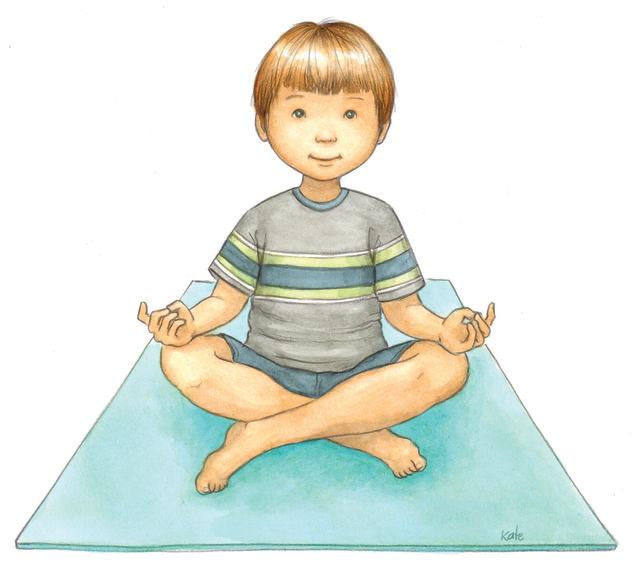
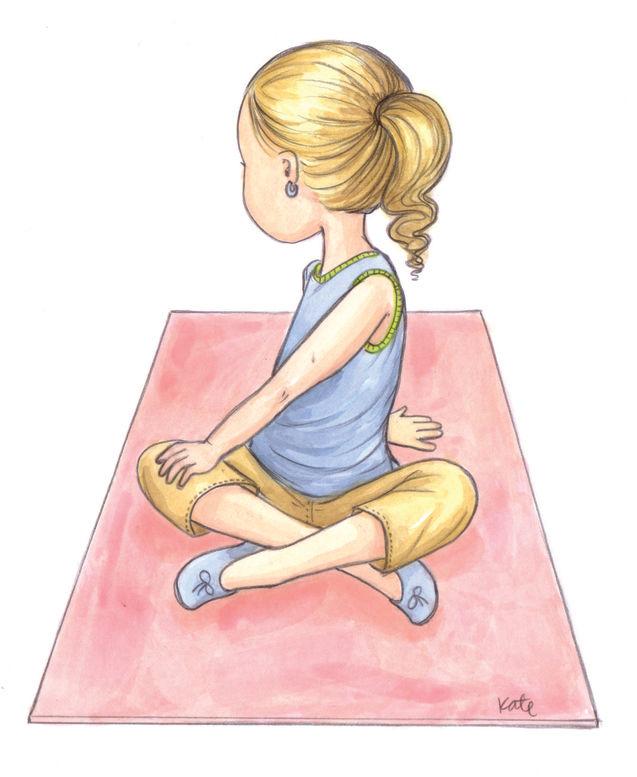
Airplane: Lie on your tummy and gently lift your chest, arms, and legs off the floor.
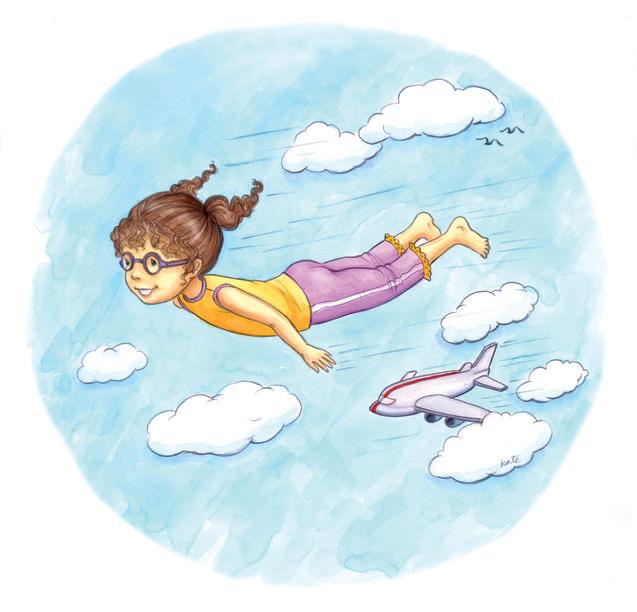
Cobra: Lie on your stomach with your elbows bent close to your side. Then gently lift up your chest, keeping your legs straight behind you.
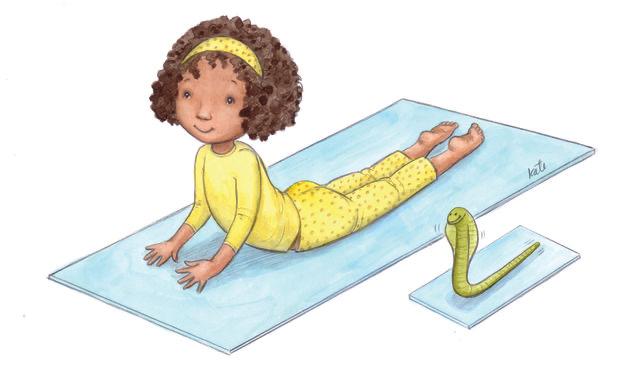
Elephant: From a standing position, fold forward and interlace your hands, swinging them side to side like an elephant trunk.
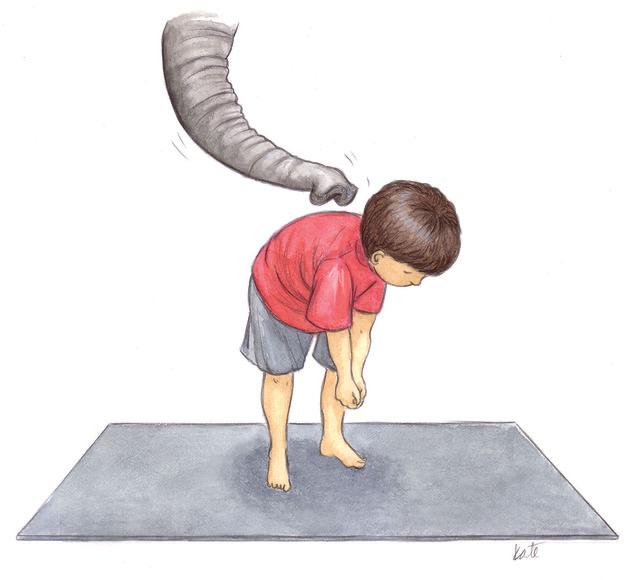
Jack-in-the-Box: Sit with your knees bent into your chest with your arms wrapped around them. Then, point your forehead to your knees and count to 3; next, inhale and lift your head, like a Jack-in-the-box popping up.
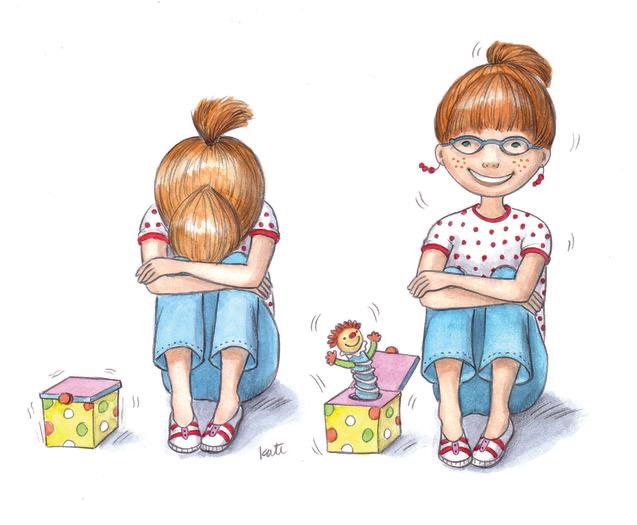
Otter: Lie on your belly with your arms out in front of you. Then slowly push up with your hands against the floor, straightening your arms and lifting your head and chest.

Yoga: Stand tall with your feet grounded into the floor. Slowly straighten your arms and lift them over your head, stretching up and making your body into the shape of the letter Y.
Lion: Kneel on your shins with your chest on your thighs. Then, on the count of 3, spring your body forward and roar like a lion!
Oyster: Sit tall with the soles of your feet together. Then slide your arms under your knees, touching your elbows to the floor with ease. Hold on to the sides of your feet as you slowly inhale and exhale through your nose, bringing your head gently toward your toes.
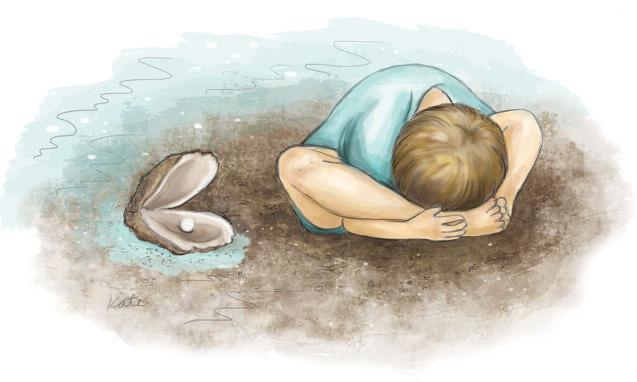
Volcano: Stand tall with your feet slightly apart, bringing your hands into prayer position in front of your heart. Next, inhale and push your hands to the sky, then exhale and move your arms to the side and then back to center, like an exploding volcano.
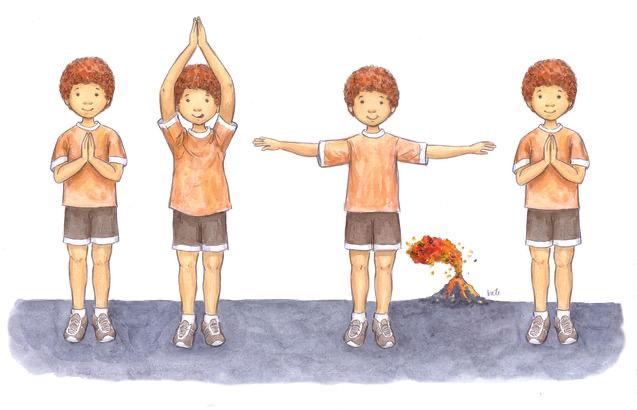
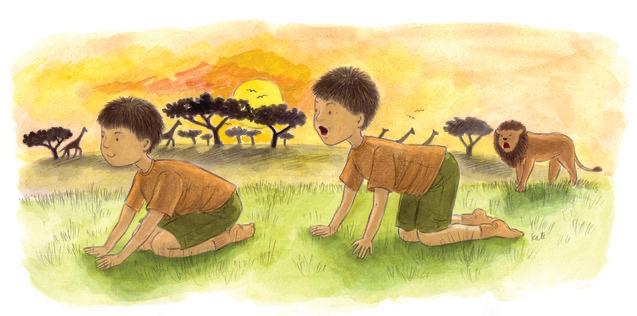
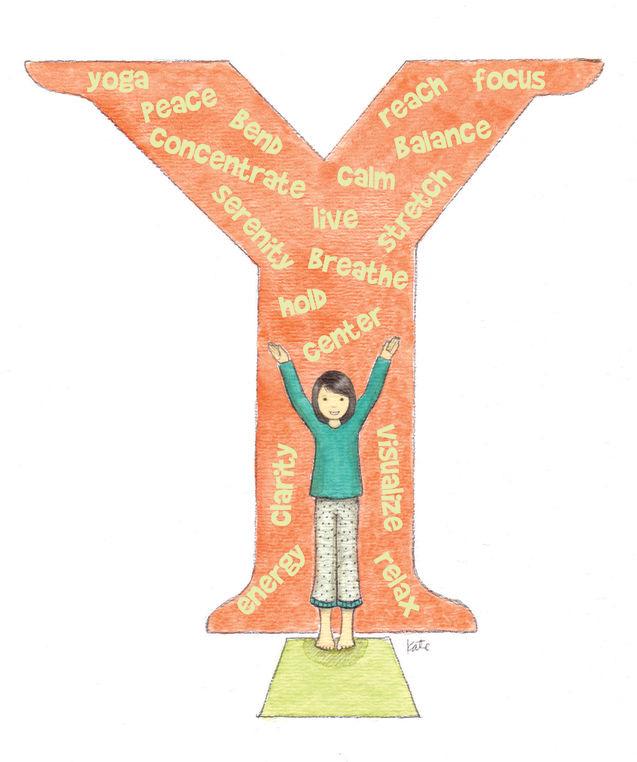
Eagle: Stand tall and then bend your knees. Bring your right leg over your left one and then cross your right arm under your left. Stay in this position for a count of 8 before switching sides.
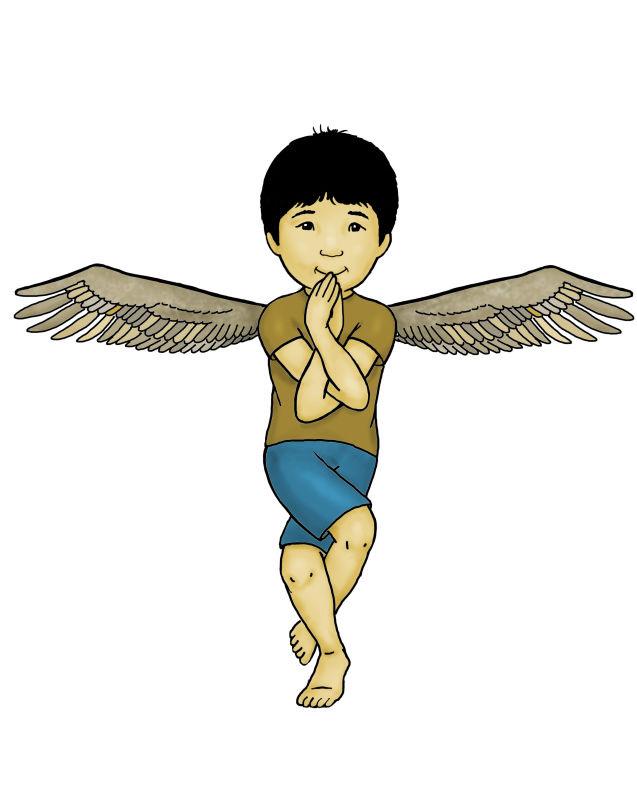
GROW YOUR FLOW!
• Yoga Poses for Kids – see handouts
More great yoga resources!
• Adapted from an except from The ABCs of Yoga for Kids, written by Teresa Anne Power and illustrated by Kathleen Rietz
• https://www.facebook.com/abcsofyogaforkids/photos
• Also recommend:
• 5 Kid-Friendly Yoga Poses To Help Children Cultivate Patience
• http://www.mindbodygreen.com/0-22827/5-kid-friendly-yoga-poses-to-helpchildren-cultivate-patience.html
• 5 Kid-Friendly Yoga Poses To Help Your Child Avoid A Meltdown
• http://www.mindbodygreen.com/0-18351/5-kid-friendly-yoga-poses-to-helpyour-child-avoid-a-meltdown.html
There’s an App for that!
• Daily Yoga
• http://childhood101.com/2015/04/yogafor-kids/
• Calm Down Yoga Routine for kids, perfect for helping children learn to manage big emotions. Complete with free printable poster.
• Youtube.com Cosmic Kids Yoga
• Relax Melodies
• Mindful Minute Virtual Hope Box (guided meditations) Stop, Breathe, Think (Meditations)
• The Worry Box
• End Anxiety
• Relax Meditations
• SAMApp
• Relax Lite
• Stop Panic (audios, articles, cognitive diary etc.)
• Mindshift (coaches through cognitive restructuring, education, tools, tips etc.)
• Calm (breathing app) FREE educator subscription
• Pacifica (improve mood, reduce anxiety, live healthier etc)
More Apps
• Insight Timer (meditations)
• Cognitive Diary CBT Self-Help (cognitive diary; articles)
• CBT Thought Record Diary
• Colorfy – Coloring Book Free
• Mandala Coloring
• Adult coloring book premium
• Anxiety Relief Hypnosis
• Social Anxiety Disorder
• Healing Sounds – Anxiety Relief
• Anxiety Free Hypnosis (Hypnosis, meditation; coaching)
• Headspace
• Smiling Mind (Age specific mindfulness)
• OMG I can Meditate!
CBT
• The anxiety that is experienced will ebb and flow. Each time the client experiences anxiety is an opportunity to practice what has been learned.
• Combines the cognitive strategies with traditional aspects of behavioral therapy.
• CBT is usually brief, goal and action oriented focusing on the problem at hand.
• It addresses the behaviors as well as the cognitions that are contributing to the problem.
• There is an emphasis placed on the interactions between feelings, thoughts and behaviors.
• Homework is very important in order to increase the generalization of the skills (Pincus, D. B., Ehrenreich, J. T., & Mattis, S. G. , 2008)
• Using CBT in conjunction with medication can “facilitate medication discontinuation and improve the chance for a full recovery” (Sudak, 2011, pg. 111).
• Anxiety and Panic are reactions. So the goal of the treatment is to teach the client new ways to react to the stimuli that is currently causing the anxious response.
• The client as needs to become a good monitor of their own thoughts, feelings and behaviors. That way they are able to relay back to you how they are doing between sessions. With children, this is where a parent can play a key role as well.
• “Patients with anxiety also must learn and practice relapse prevention strategies. Anxiety will reoccur in some form when treatment ends. Patients must not panic when this happens; they must deliberately employ strategies that have worked for them in the past. Each opportunity to practice the techniques learned in therapy and to face fears strengthens recovery” (Sudak, 2011, Pg. 109).
Exposure Therapy
• Exposure Based Treatment: The “underlying principle of exposure….gradually increasing the difficulty of stimuli confronted and staying in contact with the stimulus until anxiety reduces” (Sudak, 2011, pg. 105).
• Exposure and Response Prevention may only be tolerable in severe cases if medication is used to alleviate some symptomology.
• SSRI antidepressants and chlorimipramine work well in reducing fear without interfering in the effects of exposure and response prevention treatment.
Fear and Avoidance Hierarchy Exposure Therapy cont.
• List the situations that are avoided or cause anxiety
• Put them in order from most anxious causing (at the top) to least anxious causing (at the bottom).
• This can also involve one trigger such as a spider and the hierarchy is the distance to/from the spider
• Doing exposures as homework can be very beneficial – make sure the client documents the experience thoroughly.
•
Exposure
• Prepare in advance. Do not surprise the client with this. Work towards it and plan.
Talk about what could happen during the exposure and how it will be handled
• Control
• Client needs to feel in control
Face to fears that are more predictable first – that way you and the client will feel you have a handle on what is likely to happen
• Anticipating the outcomes and planning helps the client feel in control and this is vital.
Exposure (cont.)
• Duration
• It needs to last long enough for the anxiety response to occur
• Encourage the client to remain in the situation as long as they can
• If the situation is brief, repeat it (where is the bathroom?)
• Frequency
• Episodes of practicing should be close together
• Helps to maintain the progress
• Change of Setting
• When starting to feel more confident, try other settings (if can talk in class then next try talking at a meeting)
Exposure (cont.)
• Challenging
• Client should feel anxious Set the client up for success – do not take on the impossible
• Minimize Risks
• Minimal consequences – do not tell your boss how you truly feel about them but perhaps become more assertive with expressing yourself
• Focus on Improvements
• Regularly assess the anxiety levels so the client can see they are making progress
• Expectations
• Change takes time and will not happen over night
• There will be setbacks
• Anxiety may not go away but will no longer interfere
Exposure (cont.)
• Make sure to use cognitive strategies before, during and after exposure in order to address and challenge all anxious thoughts (Anthony and Swinson, 2000).
Exposure (cont.)
• Do not fight it
• Fighting the anxiety will make it worse
• Let it happen
• Eliminate Avoidance Behaviors
• Stop doing things to avoid or that make you feel better
• When to Move on
• Try to remain in the situation until you feel more comfortable and feel a reduction in the anxiety
• Use the diaries – this can help is so many ways including to see progress and areas to address
Social Skills Training for SAD
• When treating someone with Social Anxiety Disorder, it can often be very useful to also work with them on learning/improving their social skills. Many of these skills are more challenging for people with such anxiety.
• Because of the anxiety, the client may also not have learned the skills that are basic for some of us.
• Social Skills are tricky – there is not one set that works great. What works in one setting may not be appropriate in another.
• (Anthony & Swinson, 2000)
Social Skills (cont.)
• Eye Contact
• Body Language (open posture, appropriate space and distance etc..)
• Tone and volume
• Conversational Skills (not putting self down, telling others about yourself, open ended questions etc..)
• Public Speaking Skills
• Interview Skills
• Dating Skills (asking, questions, good topics etc..)
Social Skills (cont.)
• Assertiveness Skills – I find that this one is huge for many people with anxiety (ask for things, stand up for self)
• Conflict Skills – also very challenging for people with anxiety (how to deal with others and a disagreement)
• Listening Skills (really listening and not thinking about what you are going to say next)
• Other Skills (what is imposing, not violating privacy, reasonable requests for help etc..)
• (Anthony and Swinson, 2000)
25 Fun and Easy SEL Activities To Boost Social Skills
• . Draw With Squiggles
. Build a Classroom Web
• Lesson title: Build A Web - Interdependence Lesson
• Subject and topic: ELA, Community Building
• Grade level: Kindergarten
• Duration: 30 minutes
• Lesson summary: Students identify with each other some things they like and pass around a ball of twine. The twine represents a web and every student will be holding a part of it to keep it strong. Students will reflect on their own webs in their lives and create their own webs using crafting materials.
• Standards: ● AL.3.K.A1 Use music, art, and/or stories to express ideas, thoughts, and feelings.
• SEL in A Squiggle Directions:
• 1) Distribute a "squiggle" to each student.
• 2) Distribute the same materials to each student (pencil and crayons, markers, etc). Everyone should have the same tools.
• 3) Let kiddos turn their squiggles into whatever they like. Give them a set amount of time. I give 30 minutes, but that is because I'm using the time to talk to students while they color to gather information. ("What's your favorite color?" or "What made you turn this into a cat? Do you have a cat?"
• 4) Ask everyone to line their drawings up. Have students discuss how the squiggles all started off the same, but they evolved into something personal and meaningful. Allow time to share.
• Objectives:
• ● SWBAT create webs to represent their understanding of interdependence.
• ● SWBAT express emotions, likes, and dislikes as they engage in the web creation activity.
• ● SWBAT practice reciprocal social skills as they engage in the activity.
• Essential Questions:
• ● EQ1: What are things I like/dislike? What do I have in common with my peers?
• ● EQ2: How can I express my interests and feelings to others?
• Vocabulary:
•
● Community
•
● Helper
• ● Support system
• ● Interdependence
• Materials
• ● soft twine (over 20 feet)
• ● String
• ● construction paper
• ● pipe cleaners
• ● Markers
• ● Sequins
• ● crafting glue
• ● stickers, etc
• Lesson procedures
• 1. Ask students to sit in a circle. Ask the first student to say something they like and hand them the twine. For example, “I like string cheese!” Ask students who like string cheese to raise their hands and the student with the twine will grab the end and gently toss the twine to one of the other students.
• 2. Every student should get a turn to throw the twine and hold onto part of it. At the end all students will be holding some of the twine and it will look like a web.
• 3. Wrap up the activity by paraphrasing “You see how we are all connected by the web! We are all so different, but we fit in the same web. We should treat everyone like they are part of our web. So, when people are in our web, we can help them and support them. This is called interdependence. We need other people and things in our lives to help us! Like the sun helps the plants grow, which gives us food.
• 4. Discuss with students what happens when one part of the web falls apart, the whole web falls apart. So, webs are only strong when all of the corners are supported.
• 5. Hand some construction paper and craft supplies to each student and ask them to create their own web. What would it look like? Who would be in the web? How do they keep the web strong? Draw how you feel as a part of the web. Hang them up around the classroom to remind students how important it is to care for one another.
• Evaluation: Students will be evaluated through the creation of the web.
• Ask your students this question related to this lesson to gauge how much they learned. Did this lesson help you understand that we are all dependent on each other for something
FACE THE MUSIC
• 1. Identify lyrics in a song you enjoy that get you MOTIVATED, lyrics must be clean!
Artist:_____________________________________________
Title:_____________________________________________
Name:_____________________________________________
Date:_____________________________ ______ How does this song get you Motivated? Focus on the feelings you have when you listen to the song, the appropriate lyrics, and overall message of the song.
• 2. Identify lyrics in a song you enjoy that talk about POSITIVE COPING SKILLS , lyrics must be clean!
Artist:_____________________________________________
Title:_____________________________________________
Name:_____________________________________________
Date:_____________________________ ______ What are some positive coping skills this song mentions?
• 3. Identify lyrics in a song you enjoy that expresses GRATITUDE, lyrics must be clean!
Artist:_____________________________________________
Title:_____________________________________________
Name:_____________________________________________
Date:_____________________________ ______ How does the artist express their gratitude and to whom?
• 4. Identify lyrics in a song you enjoy that display being ACCOUNTABLE, lyrics must be clean!
Artist:_____________________________________________
Title:_____________________________________________
Name:_____________________________________________
Date:_____________________________ ______ How does the artist show accountability for their actions?
• 5. Identify lyrics in a song you enjoy that talk about CONFLICT RESOLUTION, lyrics must be clean!
Artist:_____________________________________________
Title:_____________________________________________
Name:_____________________________________________
Date:_____________________________ ______ How does the artist appropriately resolve the conflict?
• 6. Identify lyrics in a song you enjoy that talk about BUILDING RELATIONSHIPS, lyrics must be clean!
Artist:_____________________________________________
Title:_____________________________________________
Name:_____________________________________________
Date:_____________________________ ______ How does the artist establish and maintain a healthy relationship?
• 7. Identify lyrics in a song you enjoy that talk about SELF-EFFICACY, lyrics must be clean!
Artist:_____________________________________________
Title:_____________________________________________
Name:_____________________________________________
Date:_____________________________ ______ How does the artist remain confident in their abilities?
CREATE A PEACE PLACE
• This activity helps participants learn calming down strategies and brainstorm how to set up and use a "Peace Place" a special place to go when someone needs to calm himself or herself or is feeling upset or angry.
• Daniel Goleman, in his seminal 1996 book Emotional Intelligence: Why it matters more than IQ, coined the phrase “emotional hijacking” for the effect of an intense emotion like anger or fear to hijack or inhibit the thinking part of our brain. Knowing how to self-regulate, or interrupt this process, is not only a core emotional competency, it is critical to young people’s ability to access their thinking brain, restrain unwanted behaviors in and out of the classroom, and attend to the learning at hand. The strategies presented here for calming down initiate physiological responses that calm the body and interrupt the “fight, flight or freeze” response that is at the heart of emotional hijacking.
•
• 8. Identify lyrics in a song you enjoy that talk about being RESILIENT, lyrics must be clean!
Artist:_____________________________________________
Title:_____________________________________________
Name:_____________________________________________
Date:_____________________________ ______ How did the artist overcome from a bad situation?
• 9. Identify lyrics in a song you enjoy that talk about SELFMOTIVATION, lyrics must be clean!
Artist:_____________________________________________
Title:_____________________________________________
Name:_____________________________________________
Date:_____________________________ ______ How does the artist push themself to keep going without quitting?
•
• Preparation and Materials
• Materials that will make a Peace Place feel comfortable to a range of students: a rug to demark the area, drawings, photos of nature, flowers, plants, stress balls, picture books, etc.
• Lesson Plan Tab:
• • Gather Together/Warm-Up/Bell Ringer: Feelings Pantomime (10 Minutes)
Stand in a circle and ask participants on cue to quickly pantomime feelings. As they do, they should look around at the other participants’ pantomimes.
•
• Begin: surprise, happiness, excitement, disappointment, frustration, anger
• Ask:
• What did frustration or anger feel like in your body? What did you notice about how others looked when they acted out that feeling?
•
Establishing a Peace Place in your classroom gives your students a way to manage their feelings without your direct intervention. It helps them learn to recognize their feelings and empowers them to come up with strategies to calm themselves down. It will take time for your students to learn how to use the Peace Place effectively.
• Objectives
• Participants will:
1. be able to identify situations in which their emotions lead them down a path to harmful, inappropriate behavior;
2. be able to identify alternatives to that behavior;
3. learn calming down strategies; and,
4. work together to set up a place in the classroom where they can modify their behavior and feel better as a result.
• Introduce the lesson:
• Today we’re going to learn some strategies for calming down and create a way to help us calm down in our classroom when we are having difficult feelings that might get in the way of our learning or productive behaviors.
• Main Activity: Calming Down Strategies and Setting Up a Peace Place (20 Minutes)
• Begin with a quick brainstorm and charting of feelings that children have when they are ready to learn (focused, curious, calm, etc.) and then when they do not feel ready to learn (anxious, angry, scared, etc.).
• Explain that there are ways to calm down when you’re feeling upset or angry that rely on mechanisms built into our bodies. Deep breathing, stretching, and tensing and releasing our muscles all help to bring calming.
•
• Introduce Three Strategies for Calming Down
• Practice each of these strategies a few times. Begin by asking students to rate how relaxed they feel on a scale of 1 to 10 (10 being VERY relaxed and 1 being VERY tense). Check in after each activity again. Was there any change? (www.gonoodle.com has fun, free video content to use for these strategies)
1) Deep Breathing: A fun way to learn deep breathing is to pretend to blow up a balloon. Participants can hold their hands together in front of their mouths. On the count of five (1, 2, 3, 4, 5) they will blow all their air out and expand their hands to simulate an imaginary balloon being blown up. Then for a count of five they will inhale. Hold their breath for a count of two. And then begin again to blow up their imaginary balloons. Encourage students to do this as quietly as they can even though they are taking large breaths.
•
1) Stretching: Have participants reach towards the sky and extend upwards on their toes, stretching their entire body. Hold this stretch for the count of 5 and then release. Shake your body before stretching again.
2) Tense and Release: While seated, have participants raise their shoulders and clench their fists, holding the tension for a count of five.
• Now Brainstorm about your Peace Place.
• Do a go-round in which each participant completes the sentence, "A special place that I find peaceful is. . .” Discuss, if necessary, what a peaceful place is.
• • Begin by sharing your special place.
• Explain that in today's activity you will discuss setting up a special place in your classroom, which will be your very own Peace Place.
• Ask:
• What is the value of having a special, peaceful place?
• Reflect back and summarize what volunteer students share.
• Explain:
• “The goal of our classroom Peace Place is to provide a little corner or area for any of us to go when we are too upset or angry to focus, work or learn or when we are beginning to feel that way. This is not like a time-out when being asked to go somewhere separate from the group may feel like a form of punishment. Going to the Peace Place is not a punishment. It is a place to go to calm yourself down and get ready to go back to work and join the group."
• Brainstorm:
• “What are additional ways, other than deep breathing, stretching, and tensing and releasing that you can calm yourself down when you're angry or upset? These may be things you can do in the Peace Place to help yourself calm down.”
• Write down all the students’ contributions on chart paper. Some ideas to include are: draw, read, write in a journal, write to a friend, think of people you care about, distract yourself with a puzzle, hug a stuffed animal, squeeze a stress ball, close your eyes and picture a place you love to be, etc. (Note: as time goes on add to and refine this list. Post it in your Peace Place.)
• Now brainstorm what should be included in the Peace Place.
• “If the Peace Place is to be a good place to go to calm yourself down when you're upset, what things will we want to include in that space (stress ball, stuffed animals, pictures of nature, an hour glass timer, etc.)? Where should our Peace Place be? How should we decorate it?” Be sure to keep the discussion focused on how these decisions support the Peace Place being a good place for calming down.
• Discuss: When and how will we know that it is ok to go to the Peace Place?
• Here are some possible guidelines:
ü Going to the Peace Place is voluntary and only for when you truly need it.
ü You have to tell the teacher you are going (this could be an agreed upon nonverbal signal).
ü One person at a time.
ü Set a time limit of perhaps five minutes and use a timer.
• Explain that someone does not have to be angry, worried, sad, or upset to go to the Peace Place. Sometimes a five minute break at the right time can be helpful in managing one's feelings or be a time to think about something that is bothering you before reacting.
• Closing Together: Pair/Share (5 Minutes)
• In pairs have the children share: "One thing I'm looking forward to about having a Peace Place is..." Ask for a few volunteers to share what was said in their partner groups.
• Grade Level Modifications Tab:
• K-1 Follow core instructions for grades 2-5.
• Grade 6-12 Follow core instructions for grades 2-5. When establishing the guidelines for your Peace Place, give students ownership for being as concrete as possible about the intended uses and rules for the Peace Place. Have students create the guideline poster themselves using the title “In our Peace Place, we agree…..” Have each student sign the poster. You can also have students fill out the Top Five sheet for how they envision themselves using the Peace Place in class. (See handout 1.)
Curricular Connections Tab:
• K-1Literacy: Read When Sophie Gets Angry, Really, Really Angry by Molly Bang.
Ask: “Have you ever felt the way Molly is feeling? What do you think about the way she handled her feelings? What would you say to Molly about using a Peace Place?”
• Create a class journal for students to record their experience of using the Peace Place. This can be available for students to use during a regular journal writing or writers’ workshop time. The journal can be shared at future class meetings or during a read-aloud time.
•
• 2-5 Literacy: Read Alexander and the Terrible, Horrible, No-Good, Very Bad Day by Judith Viorst. Ask: “Have you ever had a day like Alexander’s? What did you do? How would having a Peace Place help?” Have students write a letter to Alexander offering him advice for setting up and using his own Peace Place.
• 2-5 Literacy: Have students write a persuasive letter to their parents, advocating for a family Peace Place in their home. Included in their letter can be the purpose of a Peace Place, suggestions for how it would look in their home, and the benefits to their family of having it.
• • K-5 Integrated Art (Group or individual project): Make Peace Jars. Materials needed: Different-sized soda bottles or food jars with labels removed. Water to fill bottles and jars, vegetable oil, funnels, different colors of glitter, food coloring. Activity: Have students choose an empty bottle or jar and fill it threefourths full with a combination of water and oil. The more oil used the slower the liquid moves, which can be more effective for calming down. Students add one or two drops of food coloring and a cup or so of glitter.
• When jars are done and sealed tightly, allow students to practice using their calming down jars. To use the jar for a calming strategy, vigorously shake it. Children then watch the glitter sink to the bottom while breathing deeply.
• IMPORTANT: Spilled vegetable oil is not easy to clean up. Caution students to be careful -and have clean-up materials handy!
• K-5 Literacy and Technology: Work with your technology teacher to help students create a “How-To” presentation for setting up a Peace Place. This could be a slide show or video and could be shared with parents, the community, or posted on the web.
• 6-12: Science Extension: Link this activity to a study of stress and our bodies’ biochemistry during fight, flight, or freeze. Likewise, study the physiology of how calming strategies such as deep breathing, tensing and releasing, meditation, and other ideas interrupt that cycle. Use of biometrics such as mood cards, dots or bracelets can help students experiment with the effect of their emotions on their bodies and the importance of being able to read their own internal signs of stress (tensing of your body, clenching of your jaw, sweating, etc.) as a guidepost that it is time to take a break.
• Handout 1 (Peace Place Lesson)
• Name ______________________________________________ Date __________________________________________ Top Five List five reasons you might use the Peace Place in our classroom. •
Non-verbal Communication
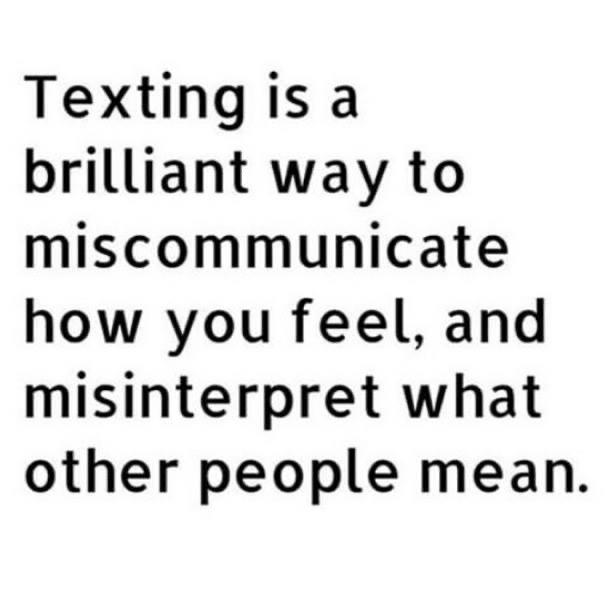
• Often when we feel anxious, especially with SAD, our body language can convey that we want to be left alone – we shut ourselves off.
• Research shows that the greatest amount of communication in a conversation, is non-verbal with statistics ranging from 75-90%.
• 3.__________________________________________________________________________________________________
•
• 4.__________________________________________________________________________________________________
• 5.___________________________________________________________________________________________________
• THAT IS A LOT
• If we are conveying we are closed off but that is not how we feel, this adds an additional challenge.
Non-Verbal Behaviors:
Closed: Open:
• Leaning back (sitting)
• Standing far away
• Avoiding eye contact
• Speaking quietly
• Crossing arms
• Clenching fists
• Serious facial expression
• Sitting hunched
• Timid tone of voice
• Leaning forward (sitting)
• Standing closer
• Maintaining eye contact
• Easily heard volume
• Arms uncrossed
• Hands open & relaxed
• Smiling
• Confident Tone
• Sitting up straight
(Anthony and Swinson, 2000)
Social Skills and Communication


• While working with a client to teach the skills, you must also deal with the anxiety underlying the issues:

• Address fears
• Resolve irrational thoughts
• Deal with catastrophic thoughts
• Rejection
• Self-esteem
Ways To Help Students Who Struggle With Anxiety
• Educate yourself about anxiety
• The more you understand about anxiety, the more you can arm yourself with strategies to help your students. This article from district superintendent Jon Konen provides a definition of anxiety, its causes, how to recognize it, types of anxiety disorders, and, most importantly, how you can help as a teacher.

• (You are obviously doing this – you are here, today!)


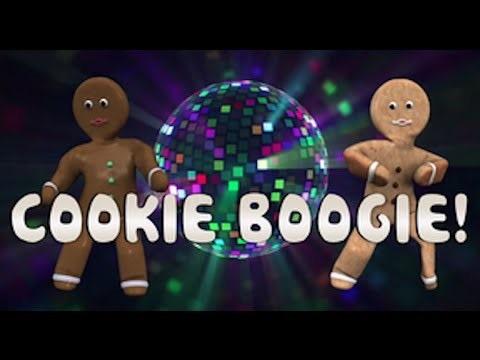
https://www.youtube.com/watch?v=zmR2A9TnIso&list=PLb98Ir0FmoPIF9snYCFt0kRmN-tWOPPiA
Building strong bonds and connecting to youth can protect their mental health. Schools and parents can create these protective relationships with students and help them grow into healthy adulthood.
Practice those deep breaths
• Rainbow Breath - Learn To Raise Your Energy | Meditation For Kids | Breathing Exercises | GoNoodle – YouTube
• When people slow down their breathing, they slow down their brain. When I notice that one of my kids is struggling with anxiety, I’ll often lead the whole class in a breathing exercise. It helps the child who is overwhelmed and usually a few other kids too. Sometimes I’ll do it just because the whole class is squirrelly and we need to focus. Slow, deep breaths are the key.
• Practice Mindfulness With Belly Breathing |… | PBS KIDS for Parents
What is Belly Breathing?
• Diaphragmatic, or belly breathing, is natural to all mammals (including humans). It’s a state of deep breathing that’s controlled by a large muscle in our abdomen called the diaphragm.
• When you take air in through your nose, it travels into your lungs. If you take a shallow breath, only the chest cavity expands. Breathing deeply involves more of your body the diaphragm contracts and both the belly and chest cavity expand. Belly breathing and the “fight or flight” response to stress or anxiety (two feelings we all experience) can’t occur at the same time. When our bodies switch into “fight or flight” mode, we engage in shallow breathing. We’re ready for battle. On the other hand, belly breathing reduces our heart rate and triggers a relaxation response. It slows us down.
Directions
1. It’s best to start practicing belly breathing when you and your child are already relaxed. This way, your child can build awareness of what being calm feels like. Once your child has the feeling of belly breathing mastered (have her practice it daily), she can apply it to stressful moments.
2. Start by having your child breathe normally. Ask if your child notices anything about it. What parts of the body move as she breathes? What does it feel like?
3. Now have your child lie on her back, relax her muscles and place her hands on her belly.
• 4. With her mouth closed, have her breathe in for four seconds or until she feels her whole chest fill with air, all the way down to her belly.
• 5. Have your child hold in the air for four seconds.
• 6. Have your child slowly blow the air out until it’s all gone. If your child is having difficulty breathing slowly, have her exhale through a straw. You can tell your child to pretend she’s snorkeling.
• 7. Repeat until the body feels relaxed. Ask your child if they notice anything different from before. What does it feel like?
• 8. Include belly breathing as a regular part of your child’s routine, such as bedtime. With practice, it can become a familiar strategy that your child can use at any age.
• Jennifer Cooper is the blogger behind Classic-Play.com, an online resource for creative families. Her favorite pastimes include: dancing around her living room, watching the Pink Panther with her kids and daydreaming. She lives in Baltimore, MD with her husband, photographer Dave Cooper, and two children.
Practice Mindfulness With Belly Breathing |… | PBS KIDS for Parents
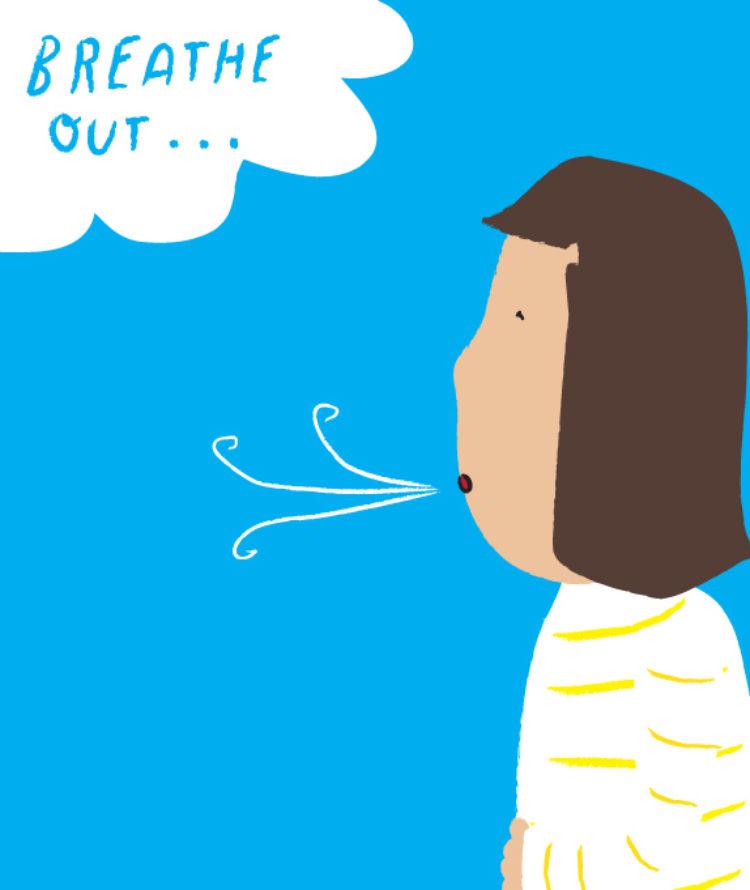
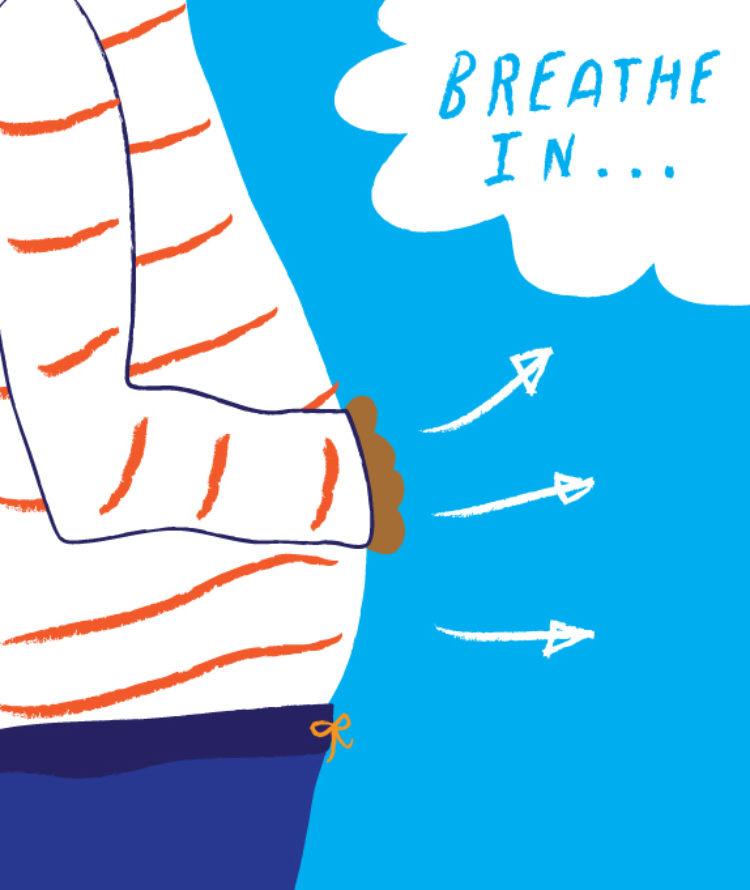
Take a break and go outside
• Being out in nature can also calm an anxious brain. Sometimes just a change of scenery is what makes the difference. Breathing the cool air or making time to notice chirping birds can also calm an overactive worrier. Asking students to carefully observe their environment can help them turn the focus away from their worries and toward something more tangible: How many different kinds of trees do you see? How many different bird songs do you hear? How many different shades of green are in the grass?
Talk openly about anxiety
• Don’t set anxiety up as something you want (or should) get rid of. It’s part of life, and it’s not realistic to think it’ll go away completely. You can help students see and understand this in your own actions.
• Tackle the topic with a good book: Often, when one of my kids is struggling, the school counselor will come and share a picture book about managing anxiety with the entire class. Some kids may not be receptive to direct, one-on-one intervention, but they will respond beautifully if they know the whole class is receiving the same information.
Get kids moving
• Exercise helps anyone who is feeling anxious. Anxiety can end up looking like anger, so if you see this, try taking a movement break. You probably already have some favorite ways to do this, but if you’re looking for some ideas, check out our video above.
• Get Students Up and Moving with Wellness Way - YouTube
Try walking and talking
• Building on the moving idea, if you have a student that needs some one-on-one attention, try the “On My Walk” activity. I used to have a student who struggled a lot with anxiety, and this worked great with her. After a couple of loops around the playground with me, everything would feel a little better. Our walk served three purposes: 1. It removed her from the situation. 2. It gave her a chance to explain the issue to me. 3. It got her blood pumping, which clears out the anxiety-producing energy and brings in the positive exercise endorphins.
• Resource #2
Focus on the positive by having students keep a gratitude journal
• The brain is incapable of producing anxious thoughts while it is producing positive thoughts stemming from gratitude. If you can trigger a positive train of thought, you can sometimes derail the anxiety. I knew a teacher who had his fifth graders keep gratitude journals, and every day they would record at least one thing they were thankful for. When his students seemed overwhelmed by negativity or mired in anxiety, he’d encourage them to reread their journals.
22 Gratitude Videos To Inspire Kids of All Ages (weareteachers.com)
Examples
1. What is Gratitude? https://youtu.be/T5Umo80x9og
2. What does it mean to be thankful? https://youtu.be/PcVQGoalfnk
3. Two-Minute Start of Day Gratitude Meditation for Kids: https://youtu.be/vRiPWGono4s
4. My gratitude jar: https://youtu.be/6TYvJh5Cwvw
5. Short gratitude stories for kids: https://youtu.be/Y3cpV_dnN_I
6. Practicing gratitude: https://youtu.be/l6zL3CtYG6Q
7. Thankful by the Juicebox Jukebox: https://youtu.be/YeSdQmO51Ps
8. Gratitude as a learning strategy: https://youtu.be/lrHJYeAVoKU
9. Gratitude Experiment: https://youtu.be/U5lZBjWDR_c
10. Gratitude for teens: https://youtu.be/uOm8qZ1brP8
11. The science of gratitude: https://youtu.be/JMd1CcGZYwU
Identifying Feelings
• Show Emoji Cards

Validate students’ feelings
• Before trying to problem-solve with students who are in the midst of racing thoughts or have completely shut down, Phyllis Fagell, a school counselor and therapist based in Maryland and Washington, D.C., recommends validating their feelings. For instance, saying, “If I was afraid I might look dumb, I’d be worried about raising my hand too,” may reduce the impact of anxiety and help a student relax, develop trust, and feel understood. Fagell also reminds teachers not to shame anxious students.
Remind kids to eat healthily and stay well
• For the most part, teachers don’t really have a lot of control over what students eat and how much they sleep, but these things do matter when it comes to managing anxiety. Not surprisingly, a healthy diet and plenty of sleep make a difference in how well a student is able to handle situations that could be overwhelming. It’s one of the reasons that snack and rest time are an essential part of the day for preschoolers!
16 Tasty Books That Teach Kids About Nutrition and Healthy Eating Habits
• 1. Rah, Rah, Radishes: A Vegetable Chant by April Pulley Sayre
• 2. Summer Supper by Rubin Pfeffer
• 3. Maurice the Unbeastly by Amy Dixon
• 4. Gregory, the Terrible Eater by Mitchell Sharmat
• 5. I Will Never Not Ever Eat a Tomato (Charlie and Lola) by Lauren Child
• 6. How Did That Get In My Lunchbox?: The Story of Food by Chris Butterworth
• 7. Tyler Makes Spaghetti by Tyler Florence
Encourage families to make sure their children are getting enough sleep
• With all the extracurricular activities available to kids, not to mention the allure of high-stimulus technology, many kids are just not getting the amount of healthy sleep they need. According to the CDC, children ages 6-12 need as much as 9-12 hours of sleep each night. Preschoolers need even more (10-13 hours), and teens need between 8 and 10 hours. A solid night’s sleep does wonders for improving mood, concentration, and outlook. Good sleep quality is also essential.
• 8. The Seven Silly Eaters by Mary Ann Hoberman
• 9. To Market, To Market by Nikki McClure
• 10. Zombies Don’t Eat Veggies by Jorge and Megan Lacera
• 11. The Princess and the Peanut Allergy by Wendy McClure
• 12. Aiden the Wonder Kid Who Could Not Be Stopped: A Food Allergy & Intolerance Story by Colleen Brunetti
• 13. Every Night is Pizza Night by J. Kenji López-Alt
• 14. Bilal Cooks Daal by Aisha Saeed
• 15. Try It! How Frieda Caplan Changed the Way We Eat by Mara Rockliff
• 16. Eat Your Greens, Reds, Yellows, and Purples: A Children’s Cookbook by DK
Create a space where kids can express their anxiety
• You’ve probably heard of classroom safe spaces, and this is a great option to offer if you have students dealing with anxiety. A safe space is a comfy zone in the classroom where kids can go to decompress and regroup. Many teachers include glitter jars, headphones, books, or other items to help kids get back on track.
Use fidgets
• Another helpful idea, which can stand on its own or be part of your safe space, is offering students classroom fidgets. Sometimes this can work wonders in just giving kids an outlet for their amped-up energy.
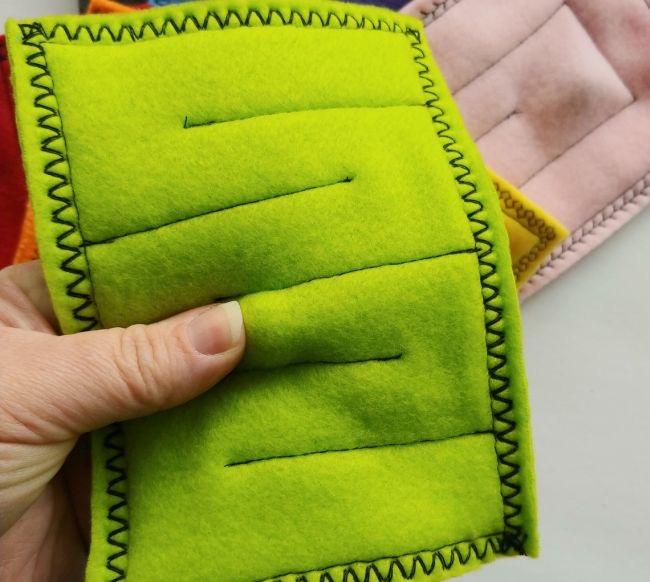
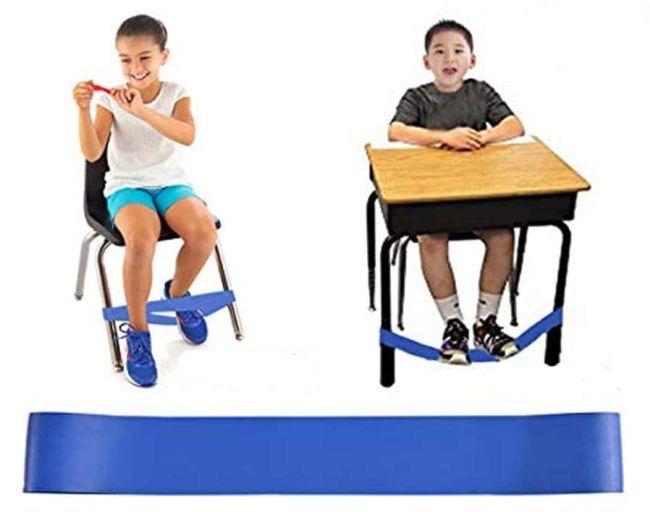
• 39 Best Fidget Toys for the Classroom (weareteachers.com)

Try aromatherapy
• Aromatherapy is thought to help activate certain receptors in the brain, potentially easing anxiety. Whether in the form of essential oil, incense, or a candle, natural scents like lavender, chamomile, and sandalwood can be very soothing. Check for sensitivities among your students before introducing a scent to the whole class. An alternative could be an unlit candle, dried herbs, or a sachet treated with essential oil kept in the classroom safe space for students to use individually.
Teach kids to recognize their warning signs
• Everyone experiences anxiety differently. For children, signs may include shortness of breath, stomachaches, or inability to settle down and concentrate, among others. Coaching students to recognize their unique triggers and warning signs can help them know when to take a step back. Integrate social-emotional strategies throughout the day to help students learn to manage their anxiety.
Integrating Social-Emotional Learning in Schools
• 1. Start each day with an emotions check-in
• Understanding how kids and teens are feeling is critical. There are other benefits to a daily feelings check-in, too. Here are just a few:
A daily check-in builds relationships by letting kids know we care. It helps learners build self-awareness. Naming emotions can help us cope with those feelings.
• It is a proactive problem-solving tool.
• Check-ins normalize talking about emotions.
• A daily check-in brings calm and mindfulness to the day.
• Managing Emotions Wheel - SEL SelfRegulation Craft & Coping Skills Lesson (teacherspayteachers.co m)

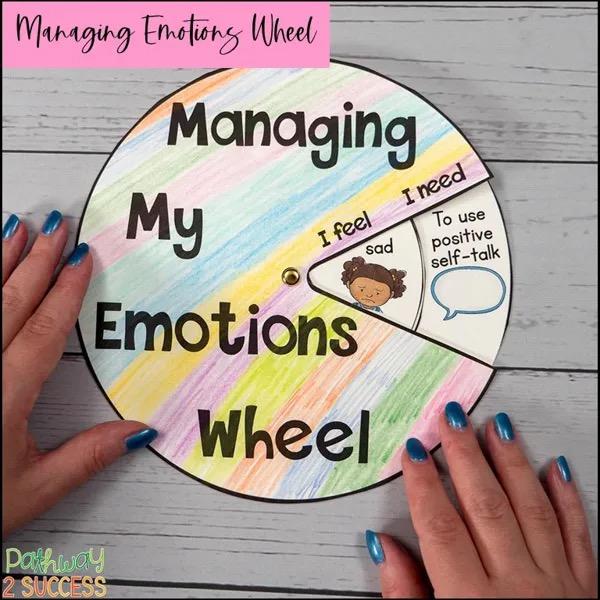

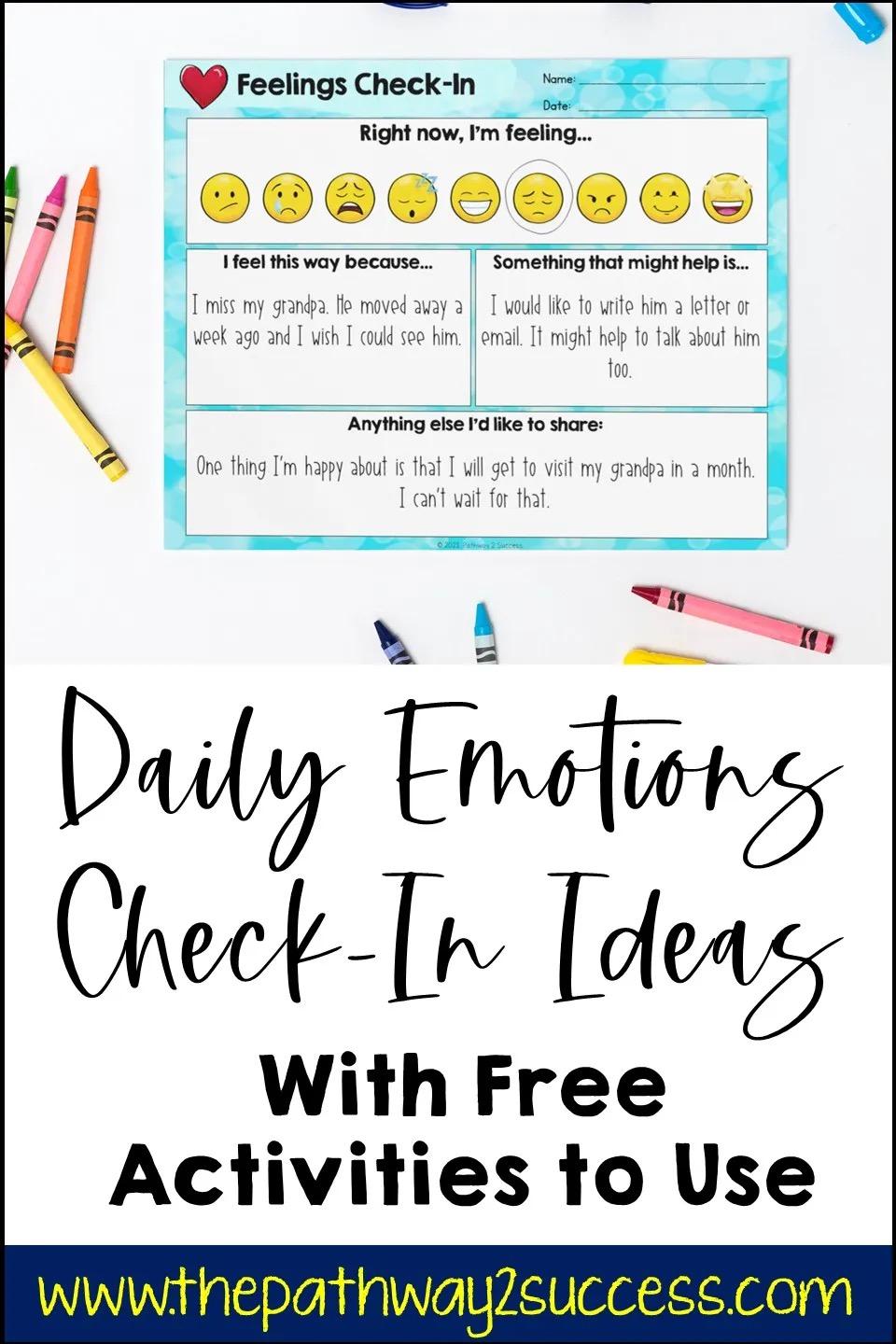
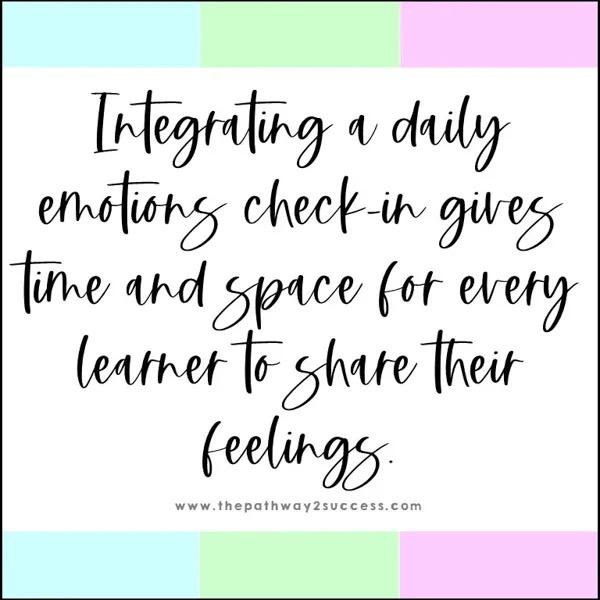
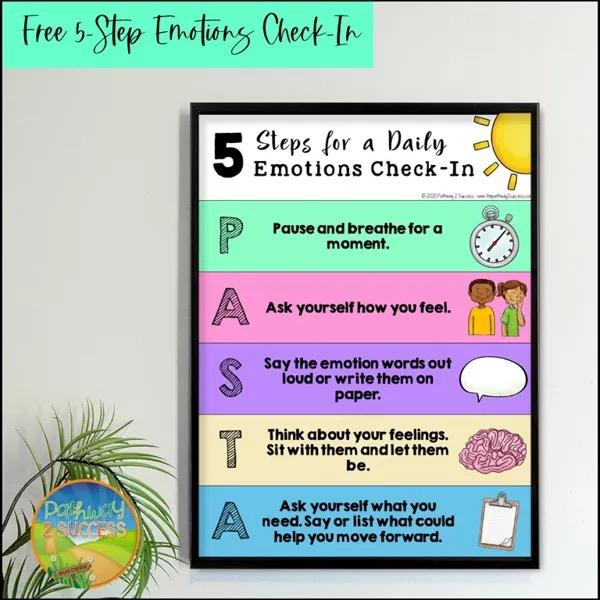
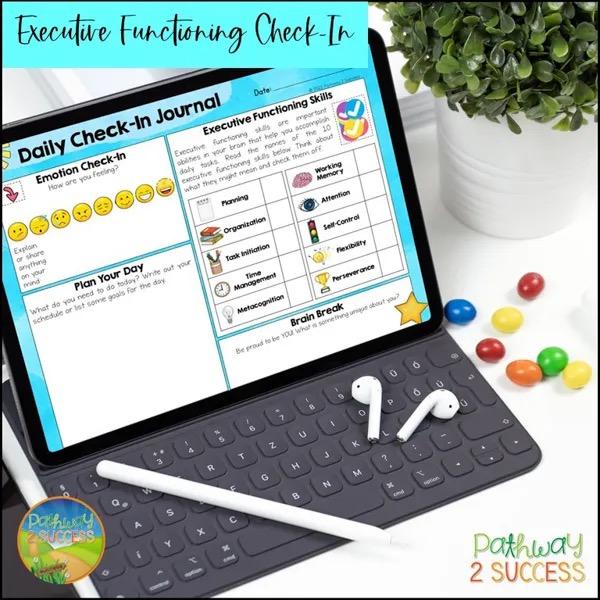

• 2. Use emojis to help kids identify their emotions

• Category - Free Printables Page 1 - We Are Teachers
• Use Transition Times for Mental Health Check-Ins (weareteachers.com)
• 3. Use story time for teachable moments
• 50 Children’s Books for Teaching Social Skills
• Best Social Skills Books for Kids, as Recommended by Teachers (weareteachers.com)
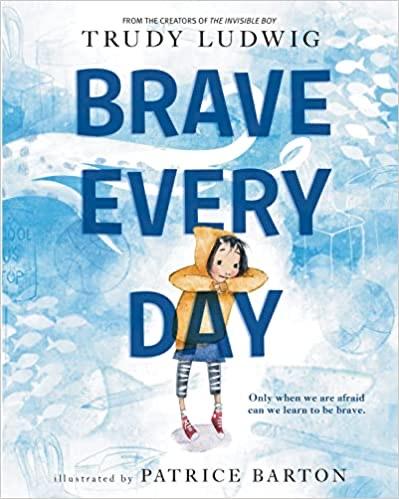

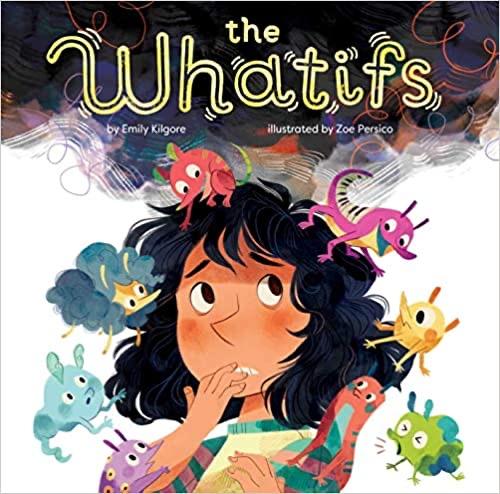
• 4. Do lots of partner activities
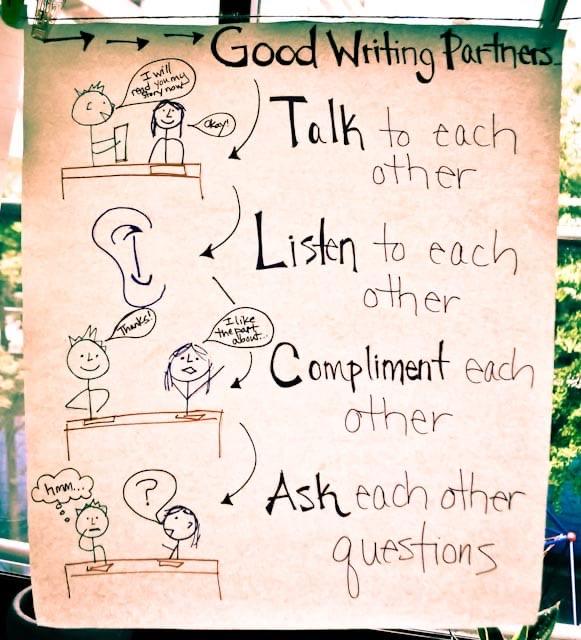
• 5. Teach kids how to work in a group
• Clear Intention: The purpose of group work needs to be clear not only to the students, but also to the teacher. Do students even know the intended outcome for why they've been assigned to work in a group? Have those expectations been clearly set? Have students set those expectations themselves? These are questions that educators need to consider as they structure group work. In addition, there are many ways to do group work, from random groupings to teacher choice to something in the middle. All choices are good, as long as you have a clear intention. Teacher choice can be effective when the idea is guiding instruction based on assessed needs. Student choice is excellent for projects and extension assignments. Whatever drives the choice, the intention of the grouping must be clear.
• Heterogeneous vs. Homogeneous: Similar to clear intention, heterogeneous and homogeneous grouping must be intentional in choice. There are pitfalls in both. Putting together students of similar ability may not always produce the desired outcome. If students in a low-achieving group do not have access to resources (teacher, materials, etc.) to complete the task, they will not reach the desired outcome. Sometimes, members of high-achieving groups fail to interact with each other, so teachers must ensure that culture is built for that. Similarly, heterogeneous teams shouldn't just be "higher and lower kids" together, but instead carefully arranged. Sometimes the high-achieving students will take over and exclude others from the learning process. Educators need to think very carefully about their construction of homogeneous and heterogeneous groupings, and the intentions for both.
• The Importance of Structure: As explained in the video about PBL, structured collaboration is key. You should not put students in groups and simply ask them to complete the task. Along with clear goals, teachers need to consider protocols and structures to facilitate effective group work. Whether it is a critique protocol or reciprocal teaching , these structures can help ensure that the group work moves along efficiently and with purpose.
• Scaffolding Culture: How are you building a culture of collaboration in your classroom? Teachers should not forget the importance of scaffolding the skills needed for students to work in groups. Paired with a good collaboration rubric, where students know what is expected of them in terms of behavior, teachers need to scaffold skills such consensus building, effective communication, and the ability to critique. Educators need to explicitly teach and assess collaboration, a critical 21st-century skill, if they want their group work to be productive.
• Individual Accountability: This can work in many ways. If you keep the group size limited, it can lead to greater individual accountability, because the work must be spread over a limited number of people. Clear and authentic roles can also lead students not only to value each other's work, but also to realize that the task or project can only be completed when everyone does his or her role and work effectively. It is also crucial that an educator builds in formative and summative assessments from these group work sessions so that he or she can check for understanding and ensure that individual learning is occurring.
• Not Just Group Work Productive Group Work! | Edutopia
• 6. Use an SEL curriculum:
• SEL Programs Get Results
• More than two decades of research shows that high-quality social and emotional learning programs pay off.
• 11percentile-point gain.
• Students who participate in a K–12 SEL program score better on standardized achievement tests.
• 18years worth of dividends.
• From six months to 18 years after SEL programs are completed, students can still derive benefits.
• 11xreturn on investment.
• Studies show that spending $1 on SEL programs is equal to spending $11 on intervention.
• Benefits of Embedded SEL
• With SEL built right into our core, intervention, and supplemental programs, you save time while giving students the support they need by:
• Building classroom climate
• Fostering student social development
• Increasing student confidence
• Encouraging student empathy
Social-Emotional Learning Curriculum | K-12 SEL Programs | HMH (hmhco.com)
• 7. Nurture a culture of kindness
• These 25 Bucket Filler Activities Will Spread Kindness in Your Classroom: These 25 Bucket Filler Activities Will Spread Kindness in Your Classroom (weareteachers.com)


• https://youtu.be/WaddbqEQ1NE
• 8. Practice role-play (see resource #3)
• 9. Build their social-emotional vocabulary
• Thanks for Requesting the Growth Mindset Posters - We Are Teachers
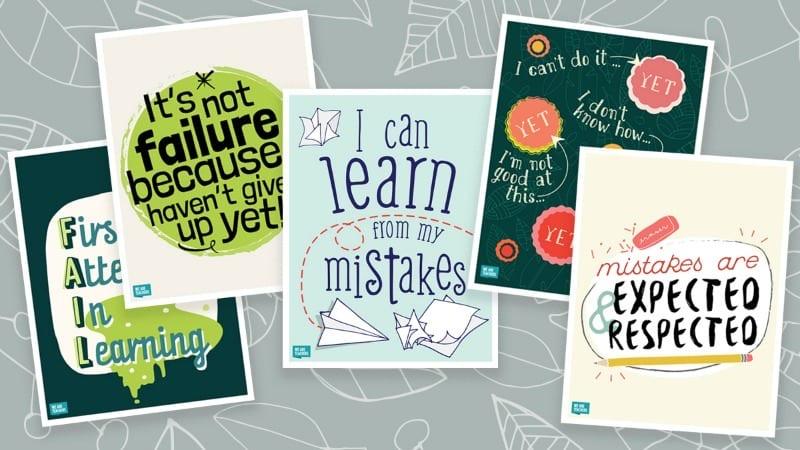
• 10. Make space for reflective writing:
• 50 Creative Third Grade Writing Prompts (Free Printable!) (weareteachers.com)
• Example for Third Grade – see resource #4
• 11. Teach decision-making skills
• Five Ways To Improve Children’s Decision-Making Skills
1. Encourage young people to use decision-making steps
• As children develop skills for reflecting on decisions, discuss the following steps and explain how they can be applied to everyday scenarios:
• What decision needs to be made
• What are the options
• Evaluate the options and pick the best one
• Act on your choice and see how it works.
• 4. Encourage children to set goals
• One vital skill, that is oftentimes forgotten among children but also adults, is goal setting. Being able to set SMART goals and achieve them is a life skill which when taught at an early age, gives not only focus, but also self-awareness and confidence moving into adulthood. Something as simple as learning to play new sports or learning how to play a musical instrument can be good opportunity to teach goal setting to young people. This shows the importance of decision making in planning and execution, and it then also allows children to form learning pathways, not only in a physical sense, but socially and emotional as well.
• 5. Ask questions which promote astute decisions
• “What do you like about that?”, “What makes this the best option?”, “How would this work?”
• These are all examples of good questions you could be asking your children to spark thoughtprovoking conversations. Such questions allow young people to be mindful of their choices and aware that there will be some sort of reaction or consequence to it.
• By no means is this every tool that can teach good decision-making, however it is the perfect place to start!
• To teach good decision-making skills is to empower our younger generation, in making positive life choices regarding their social, emotional and physical wellbeing as they navigate the challenges of life moving towards adulthood.
5 Ways to Improve Young Children's Decision-Making (lifeskillsgroup.com.au)
• 14. Teach kids how to manage conflict with peer mediation
• Step 1: Negotiation: teach all students to negotiate constructive resolutions to their conflicts.
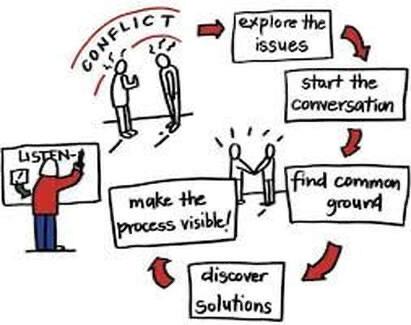
1. State what you want: “I want to use the book now.”
2. State how you feel: “I'm frustrated.”
3. State the reasons for your wants and feelings: “You have been using the book for the past hour. If I don't get to use the book soon, my report will not be done on time. It's frustrating to have to wait so long.”
4. Summarize your understanding of what the other person wants, how the other person feels, and the reasons underlying both.
5. Invent three optional plans to resolve the conflict.
6. Choose one plan and shake hands.
• 2. Involve them in everyday decisions
• Include children in your own decisions and ask them for advice. You could say:
• “I’m trying to decide whether to take up rowing or do yoga classes, to increase my level of fitness activity. Which one do you think I should do?”
• Then go over the pros and cons of each suggestion so that your child can learn how to thoughtfully consider different options, to then be able to make an informed decision.
• 3. Give children the chance to practise making choices
• Giving young people the opportunity to make their own decisions helps build a sense of independence and empowers them to make choices with integrity. It is important that the decision truly is their own though. In order to empower them to make the right decision, provide them with a few different options that would all be acceptable for you, no matter which one they choose. In this way, you are making them feel confident that they can make good decisions, by then demonstrating interest in their choice, you show that the child’s decision is important.
• 12. Set up a calm-down corner
• Create a special place in your classroom for kids to take a break when they are upset or angry or need to calm themselves. This space should have a peaceful atmosphere and might include comfy pillows to sit on, noise-canceling headphones, journaling materials, calming images, and/or books about peace.
• 13. Allow for talk time
• Simply talking is one of the most effective social-emotional learning activities. Give your students a lot of opportunities both structured and unstructured to talk to one another during the course of the day. Bouncing ideas off of one another or figuring out problems with a little give-and-take will help your students build understanding and confidence. When your class is cracking up and getting wiggly, taking a five-minute chat break is a great way to hit the reset button. (See resource #5 Discussion Starter cards).
Step 2: Conflict Mediation: teach all students how to mediate constructive resolutions of their classmates' conflicts. Mediation is the utilization of the services of another person to help settle a dispute. The purpose of mediation is to help classmates negotiate a constructive resolution to their conflicts.
1. “Mediation is voluntary. My role is to help you find a solution to your conflict that is acceptable to both of you.”
1.“I am neutral. I will not take sides or attempt to decide who is right or wrong. I will help you decide how to solve the conflict.”
2.“Each person will have the chance to state his or her view of the conflict without interruption.”
3.Solve the problem.
4.Do not resort to name calling.
5.Do not interrupt.
6.Be as honest as you can.
7.If you agree to a solution, you must do what you have agreed to do.
8.Anything said in mediation is confidential.
• Step 3: The Peacemaker Program
• the teacher selects two class members to serve as official mediators each day. Any conflicts students cannot resolve themselves are referred to the class mediators. The mediators wear official T-shirts, patrol the playground and lunchroom, and are available to mediate all conflicts. The role of class mediator is rotated throughout the class so that each student serves as a class mediator an equal amount of time. Mediating classmates' conflicts is perhaps the most dramatic way of teaching students the need for the skillful use of each step of the negotiation procedure. Refresher lessons are taught once or twice a week.
• Teaching Students to Be Peer Mediators (ascd.org)

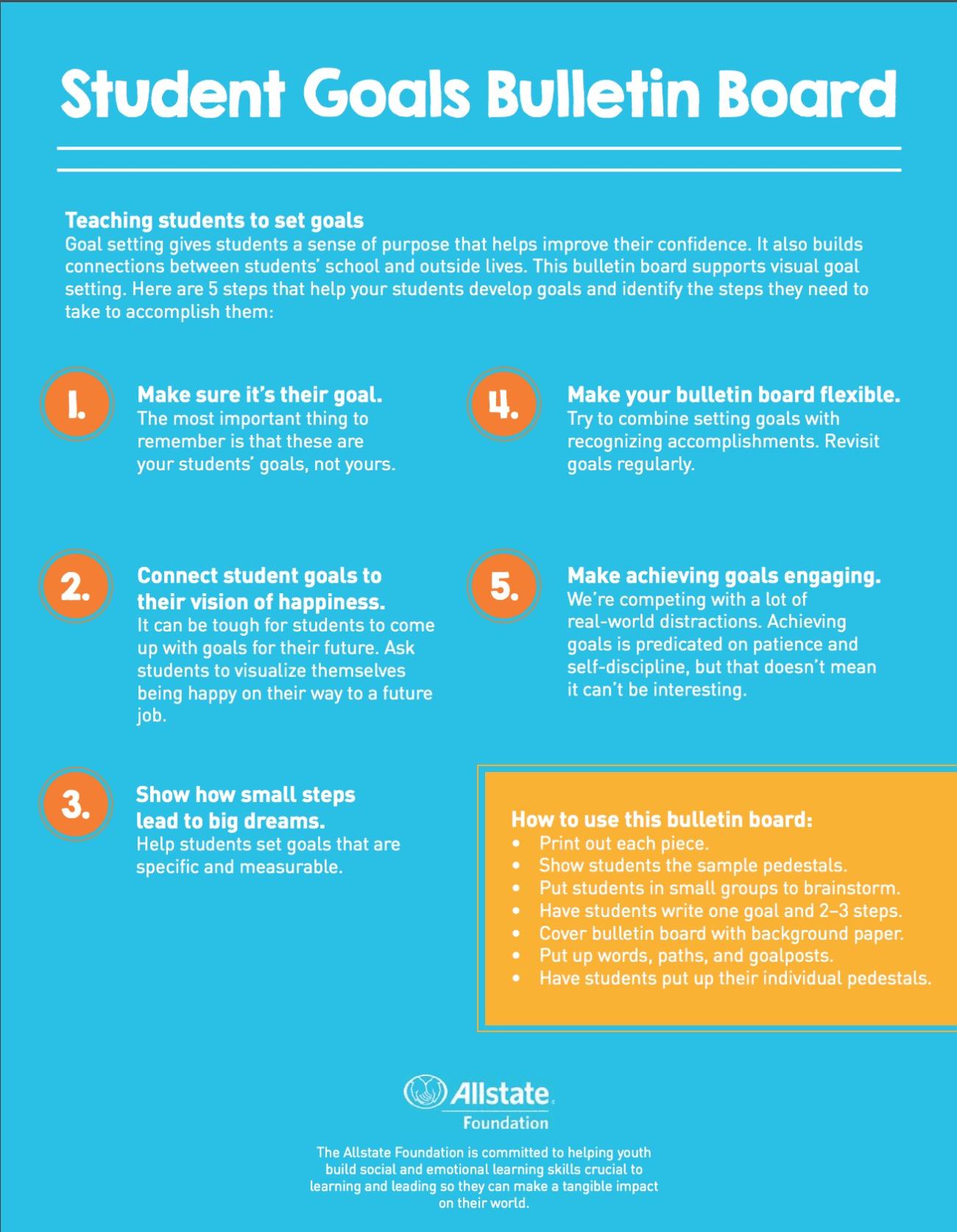
• 15. Teach students to monitor their own progress
• 16. Use anchor charts to teach socialemotional skills
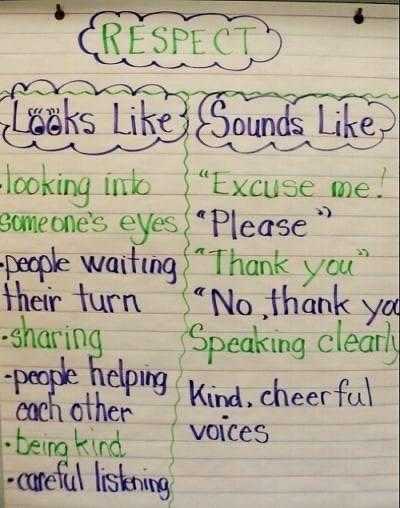
• You can create anchor charts with your class about many different topics, from “Owning Your Learning” to “What Does Respect Look Like?” and “Be a ProblemSolver.” Check out the WeAreTeachers classroom-management anchor charts Pinterest board for many more ideas.
Goal-Setting Kit to Promote SelfAwareness and Decision Making (weareteachers.com)



• 17. Create “I am” self-portraits
• Reflecting on what makes them special enhances children’s self-awareness. Ask your students to make a list of the character traits that make them unique, traits that they are proud of. Next, have them draw an outline of the profile of their face, and inside of the outline, have them write out their powerful statements.
• 18. Build community with teams
• Consider an alternative seating arrangement that allows kids to sit in teams. Let each team create an original name, motto, and flag. This is a great way for students to feel a sense of belonging, and it encourages collaboration and cooperation. Change up teams every 6 to 12 weeks.
• 19. Play games to build community
• Cooperative-learning games can promote social and relationship skills. There are tons of SEL resources out there including activities to play in your classroom. Here are 38 awesome team-building games and activities
• 38 Awesome Team-Building Games and Activities for Kids: Best TeamBuilding Games and Activities for the Classroom (weareteachers.com)
• https://youtu.be/YwP9bYEFyhU
• 20. Cultivate friendship
• Friendship comes easy for some kids; others may need a little coaching to be a good friend. There are lots of ways to cultivate friendship in the classroom, but one of our favorite methods is with videos. Here are 12 of our favorite videos for teaching kids about friendship. (12 Friendship Videos to Build a Happy Classroom Community (weareteachers.com)
• https://youtu.be/t4Q_B0fIrJE
• https://youtu.be/59tKl37x1d4
• https://youtu.be/o1WJnbJDTS0
• 21. Build self-esteem with paper beads
Ask your students to think about what makes them special and strong. Hand out several long strips of colored paper to each student. Then, instruct them to write a positive sentence about themselves on each strip. Next, have them tightly roll each strip of paper around a pencil and secure the strip together with tape at the end. Once they have created a handful of positive rolled paper beads, students can string them together with yarn to create a necklace or bracelet to remind them of how unique they are.
* 22. Set up a shout-out board
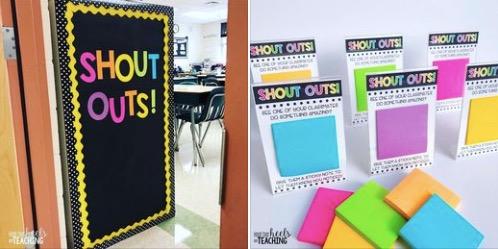
Teacher Joanne Miller recommends a shout-out board as a guaranteed way to build community. “Any improved behavior, an act of kindness, progress on a goal,” she says, “anything students think should be SHOUTED OUT to make their classmate feel good about the choices, actions, and risks they’re taking in our class should be celebrated.”
• 7) Technology Projects Introducing younger students to technology can be made easier with older buddy class partners; students can complete a project together while learning new software or hardware; teams can then share out their project.
• 8) Writing Stories Students can write a story together; then share out together; older students could type while younger students can help develop the story.
• 9) Modeling School Procedures Older students can support younger students by modeling what it looks like and sounds like to walk down hallways, exit or enter school, ask for help, etc...
• 10) Assembly Partners During assemblies older students can sit with their younger buddy partners; modeling is key here.
• 11) Creating Buddy Class Logo, Team Name, and Saying Creating a team atmosphere by each buddy classroom team creating a logo and having an inspirational saying associated with the team.
• 12) Playground Assistants Older students are placed with younger students to teach them how to use the playground equipment; older students can help run games and activities outside; if your school has the Peaceful Playground games, older students can model and teach the younger students.
23. Buddy up with an older or younger class
• 1) Reading Buddies younger students can read to older students and vice versa, create book commercials together, book chats, and more.
• 2) Art Projects create art projects together; if there are more intricate processes to the art project, save them for the older buddy partner.
• 3) Science Experiment Teammates create a science experiment that buddies can do by collecting data, building, and then experimenting; share out the findings together.
• 4) Discipline Buddies when a student owes time or is not ready to participate, they can do a time out in other buddy classroom; sending a note can help the receiving teacher know how they can support the student.
• 5) Sharing Good News When a student does something to celebrate, they go to their buddy room and receive praise, a cheer, or even earn time with the buddy classroom.
• 6) Field Day At the end or start of the year, older students could set up track and field events; or an obstacle course for the younger students, then support the younger students as they participate, or they can participate with them.
• 13) Cleaning Crew Buddy partners clean up around the school together; make it into a contest by weighing each team's bag of garbage.
• 14) Partner Walking When a student needs a break from the classroom or other activity, a buddy partner can walk with them in a designated area; this can be used in a Behavior Intervention Plan with supervision.
• 15) Fundraising Teams Buddy classrooms can raise money for a cause; classrooms can compete against each other throughout the school; buddy classrooms can set up and organize a team or even a school-wide fund raiser.
• 16) Breakfast Buddies/Lunch Buddies Buddy partners can eat with each other for breakfast of lunch; this may be used as an incentive or for modeling opportunities.
• 17) Crosswalk/Dismissal Partners Older buddies can support younger students across the crosswalks either coming to school or at dismissal; older students can help their little buddies with any other high traffic areas before or after school.
• 18) Reward Incentives A classroom can earn points to spend more time with their buddy classroom; or another variation is when both classrooms attain a certain specified goal then they get to do something fun together.
• 19) History Partners Buddies can partner up to learn history; older students can help research historical people, places, or events; students can create a project together; students can partner to create a wax museum and share out their historical figure.
19 Ideas Showcasing Power of Buddy Classrooms | Teacher.org
• 24. Encourage “helping hands”
• Learning to care about the needs of others is a critical social-emotional skill. Try this fun activity: Have students trace or draw their own hands. In each hand, have them brainstorm ideas for what their helpful hands can do for others.
• 25. Learn what works for other teachers
• What better source for inspiration than other classroom teachers? Check out these 25 SEL activities from Share My Lesson. You’ll find self-calming strategies, learn how diversity enriches a community, learn about empathy, and more.

Incorporate Zones of Regulation strategies
Students with anxiety need concrete, easy-to-use strategies to help them cope. Rooted in cognitive therapy, Zones of Regulation is a curriculum developed to help kids understand and learn to manage their emotions.
My Keep Cool Cards
• Big feelings can be so overwhelming – show cards
Offer individual accommodations
• For older students, accommodations can make all the difference. Many students struggle with performance anxiety, especially when it comes to tests. When a student is feeling anxious, their brain simply can’t function as effectively. When we can set up our tests and assignments so anxious kids are less stressed, they’ll likely perform better. Extended time and cue sheets could help kids who suffer from test anxiety.
• The good news about anxiety is that it is one of the most manageable mental-health struggles that children face in the classroom. With the right support and strategies, most children are able to develop strategies that help them manage their anxiety.
• The Child Mind Institute offers a “Symptom Checker” to help inform you about a student’s possible diagnoses and information and articles to help facilitate a conversation.
Accommodation Examples
• While each child is different, the following compilation includes commonly implemented interventions for anxious children These items may serve as a starting point for families who are looking for specific suggestions for problem areas, or for parents who are just learning of the types of issues that their anxious child may be contending with
• Classroom environment
• Anxious children perform best in a calm, supportive, but organized classroom Because change and uncertainty can be unsettling, a structured classroom, calmly disciplined will let children feel safe and know what to expect An ideal situation is a teacher who maintains authority positively, using reason and respect rather than fear for punishment
• Seating Within classroom
Anxious children often struggle with the unlikely fear that they will get in trouble, seating away from more rambunctious classmates will be less distracting, and may help them focus on their work rather than feeling responsible for the class
• Following directions
Concerns about getting the directions wrong either because of distraction or misunderstanding are common Signaling the class first when giving directions (flashing lights, clapping hands) and when possible having directions written on the board or elsewhere may assure anxious children that they have understood the directions
• Class participation
Fears of getting the answer wrong, saying something embarrassing, or simply having other kids look at them may be concerns for an anxious child Determine the child's comfort with either closed ended questions (requiring a yes or no) or with opinion questions, start with whichever is easiest Use a signal to let the child know that his turn is coming Provide opportunities for the child to share knowledge on topics in which he or she is most confident
• Class presentations Children with extreme social anxiety may have difficulty with oral reports
Consider having the child present to the teacher alone, or have the child audiotape or videotape the presentation at home
• Answering questions at the board
For children with social anxiety, the combination of getting the answer wrong, and being visible to the whole class may be so overwhelming that they may opt to avoid school altogether Consider having the child exempt from going up to the board until they are ready to handle that challenge, or, begin to approach that situation by eliminating the risk of being wrong, by simply asking the child to write the date on the board
• Testing conditions
Extended time on tests will ease the pressure on anxious children, and just knowing that the time is available may obviate the need to use it Sometimes anxious children become distracted when they see other children working on their tests or turning them in, they may inaccurately assume that they don't know the material as well Testing in an alternate, quiet location may be preferable for some children Consider the use of word banks, equation sheets, to cue children whose anxiety may make them "blank out" on rote material
• Lunchroom/recess/unstructured activities
Free choice times can be a welcomed and necessary break from the pressures of school, but fears of rejection in the cafeteria or on the playground can take the fun out of free time Bridge the gap socially by creating ties between small groups of children A lunch bunch with two or three children can create a shared experience which kids can then draw on later When working in pairs or small groups, don't always have children choose the groupings themselves, alternate this with a "counting off" technique or drawing straws to allow variability in the groupings
• Safe person
Having one person at school who understands the child's worries and anxieties can make the difference between a child attending school and staying home A guidance counselor, principal, nurse, or teacher can be identified as a point person for the child to check in with briefly (5-10 minutes) to help dispel worry thoughts, take deep breaths and return to class
• Cool down pass
Pressures build for anxious children, being able to leave the situation briefly to get a drink of water or wash their face can allow them to clear their heads and return to class on a less anxious track Since anxious children may be hesitant to ask for this and risk being the center of attention, use an orange card which the child simply places on his desk, or the teachers desk, which signals they are out on break In general anxious children are exceedingly honest and responsible and will not take misuse this privilege
• Assemblies/large group activities
Some children become anxious in crowds, until a child has mastered the auditorium, allow them to sit where they feel most comfortable (e g , at the end of the row in the back of the auditorium), see if they can gradually rejoin their class
• Return after illness
Ever responsible, anxious kids may be very distressed about work they have missed while they were out Assign a responsible buddy to copy notes and share handouts If tests are given the day of the child's return, give them the option to take the test at another time and use the test-time to make up any other missing work
• Field trips
Compounding the daily stress of the anxious child, field trips include the factors of being away from home and parents, and a change in routine Accommodate the child's level of readiness so that he or she can participate as fully as possible Consider having the child in the "teachers's group," or having parents accompany the group until the child is ready to handle an excursion without these supports in place
• Change in routine/substitute teachers
Because anxious children try very hard to please and predict what is required in a situation, changes of any sort may be experienced as very stressful When possible, send a note home the day before to alert the child/family to a change in routine, this will allow the child to process the change in his or her comfort zone and will make the transitions go more smoothly the next day
• Fire/safetydrills
While these drills are for a child's safety, anxious children may be very distressed by imagining that these events were actually happening If there is an opportunity to signal the child in person just before the alarm sounds, this may buffer the surprise of the drill and allow children to mobilize with less distress
• Homework expectations
If children are spending inordinate amounts of time on homework because of OCD redoing, rechecking, rereading, or simply worrying that the assignment wasn't done thoroughly enough, the teacher can set a reasonable amount of time for homework and then reduce the homework load to fit into that time frame. Teachers can also provide time estimates for each assignment (this could be helpful to the entire class), so that the anxious child can attempt to stay within 10% of the estimated time. Eliminate repetition by having the child do every other math question, reduce reading and writing assignments, consider books on tape if a child is unable to read without repetition, for a child with writing difficulties, consider having a parent, teacher, or another student "scribe" for the child while he or she dictates the answers.
The Children's and Adult Center for OCD and Anxiety
Mind your classroom management
• Schools play a critical role in helping students manage anxiety by creating environments where all students feel that they are cared for, supported, and belong. Certain classroom management approaches strengthen school connectedness. From teacher expectations and behavior management to student autonomy and empowerment, these strategies make a difference.
Teach inclusivity
• Poor mental health is a growing problem for children and adolescents. According to a JAMA Pediatrics meta-analysis of 29 studies including 80, 879 youths, the prevalence of depression and anxiety symptoms has significantly increased, remains high, and therefore warrants attention.
• And some groups are affected more than others. In a report by the CDC, feelings of anxiety and depression were found to be more common among lesbian, gay, or bisexual students and female students. Almost half of lesbian, gay, or bisexual students and nearly one-third of students not sure of their sexual identity reported they had seriously considered suicide far more than heterosexual students. It is essential that schools put serious effort into creating safe, inclusive classrooms and invest in curricula that supports equity.
From weareteachers.com – Resource #1
Approaches to Support School Connectedness
• School Connections:
• School connectedness is the belief held by students that adults and peers in the school care about their learning as well as about them as individuals.
• Students who feel connected and engaged at school are less likely to report risky behaviors (such as early sexual initiation, substance use, violence, and suicide) and have more positive academic outcomes.
• Classroom Management
• Classroom management is the process that teachers and schools use to create positive classroom environments in face-to-face or virtual learning modes.
• Classroom management includes teacher- and studentled actions to support academic and social-emotional learning among all students.
• Well-managed classrooms that incorporate positive behavior management strategies are one way that teachers and other school staff can build school connectedness.
• Instructional Monitoring & Support.
• When teachers use instructional approaches that 1) monitor the needs of students and 2) explicitly focus on increasing students’ interest and engagement (combined with other classroom management approaches such as those reported above), students report higher levels of engagement and connectedness.
• For example, when teachers demonstrated a number of classroom management skills including awareness and responsiveness to students’ needs (e.g., walking around the classroom and checking in on students) and maximizing students’ interest and engagement in learning (e.g., using interesting and engaging lesson materials & active facilitation), students were more likely to report a strong sense of peer community and school bonding.
• Content Relevance.
• Students report higher levels of school engagement when teachers demonstrate a variety of strong classroom management skills and make classroom content useful and relevant to them.
• For example, when students perceived that their teachers had high expectations for them and connected classroom content to their lives and future goals, they were more engaged and involved at school.12 Teachers may increase school connectedness by ensuring that all students from diverse backgrounds have opportunities to engage in content that includes individuals, communities, and experiences that reflect their own.
SAND TRAYS:
Expressive arts Therapy on Sterioids
• This technique begins with a bin such as an under the bed storage container that is filled about a third of the way with sand. The play area should contain a number of small objects, figures, animals etc. The client is invited to create a world in the sand. This can involve creating patterns in the sand or placing objects in the sand.
• The individual may create scenes that are meaningful, experiences, fears, hopes etc.
See what the client shares with you. This can often be a means of communicating with your things that can not otherwise be verbalized.
SAND TRAYS(cont.)
• Often a client may not even understand the symbolism of what they have created. But, the therapist can help the client understand the relationship between the world they have created in the sand tray and their own world.
• With individuals who have been abused , neglected or experienced some kind of trauma, the sand tray becomes on important medium to communicate because they may not want to communicate otherwise. Once familiar with the tray, this becomes a safe place and a medium they are comfortable with and will use to communicate with you.
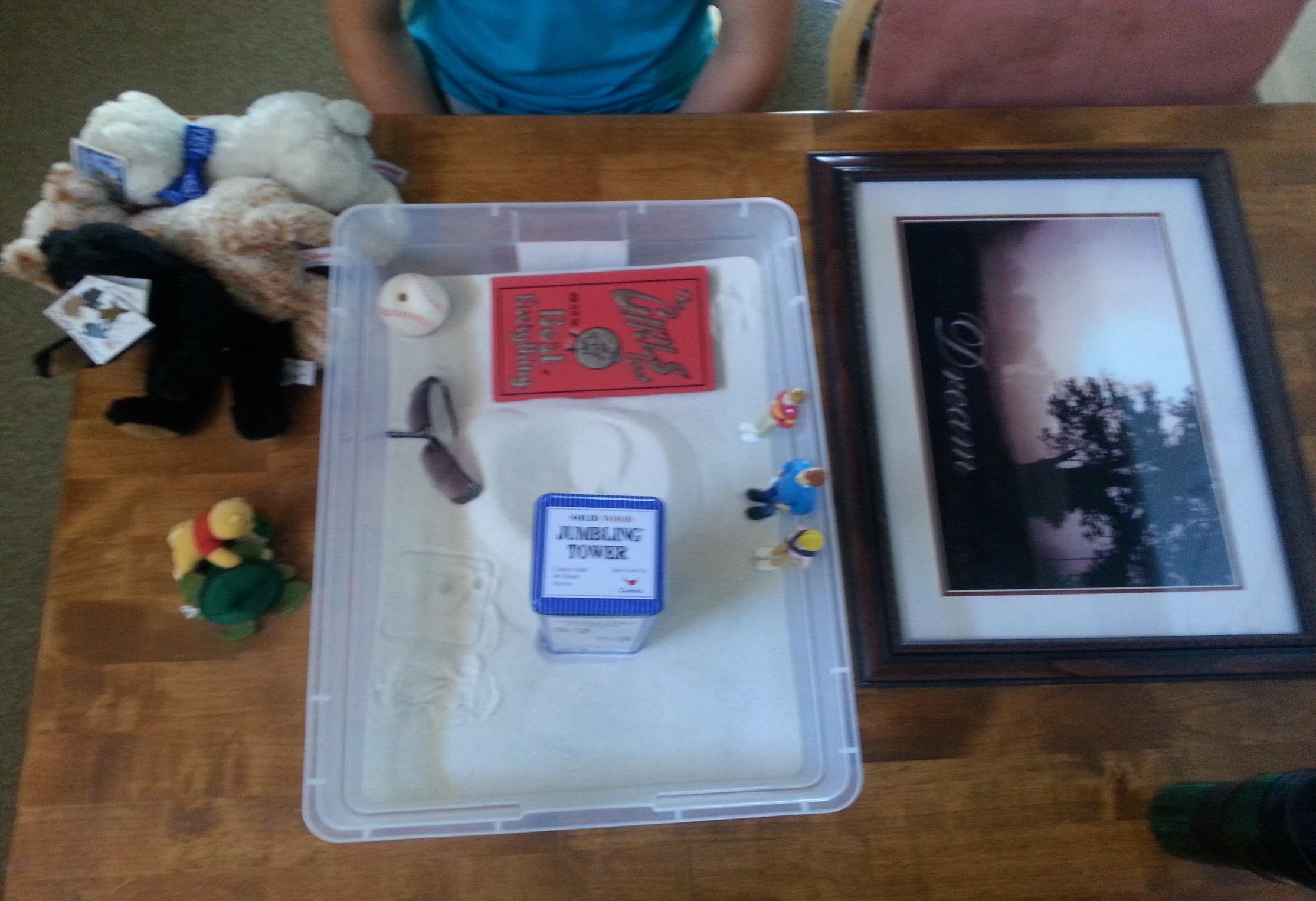
• Often by using the tray repeatedly, the client will create worlds that allow for healing. They may never speak but can take action that enables them to heal.
Sand Trays
• Great for individuals age 3 and older.
• The therapist is not there to interpret. Be careful to not make any assumptions. Listen and that can be with your eyes as well as with your ears.
• Children can learn to problem solve by the examples set using the sand tray.
• Children may play out their day and not the traumatic event that they have experienced.
SAND TRAYS
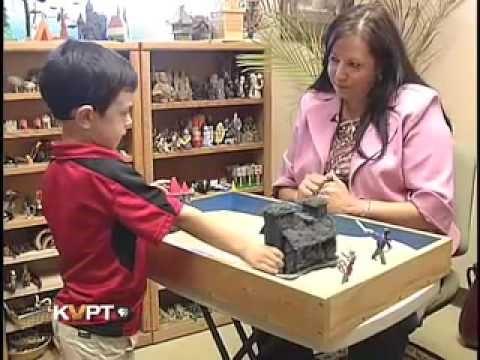
• The role of the therapist:
• Guides – you need to help the client fully engage in the sand tray and really create a world. This can include helping the client build their world when first starting to use the sand tray. It can also include support and encouragement.
• Integrate other techniques – this can include narratives, music etc.
• Use this when other techniques are not working.
• http://www.youtube.com/watch?v=ydG6Ynzrp2Y
• Do not be intimidated
• Great substitute for communication – adults and children
• Play out day
• Listen – Don’t interpret; be cautious
• Control
• Safe environment
• Age 3 and under
• Non-verbal processing
• Kevin’s Sand Tray
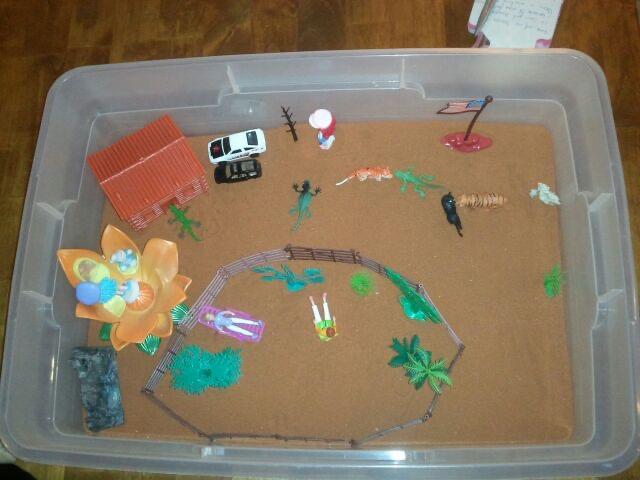

• He explained that he separated his life into multiple categories
• Baseball = Athletics were are things he loves to do and can always strive to be better at. He also talked about how he works through things that are bothering him such as if he is having a bad day through athletics and exercise.
• The family = good support system. He said that this is he and his parents. “People I can always talk to, we work through things. I couldn’t ask for better parents, better people in my life”.
• Book= academics. He stated that they are not always easy. “I’m someone who always strives to do the best I can”.
• Sunglasses = a metaphor (he said that) for the worries he has: “Am I cool enough?”, “Do people like me?”, “Does that girl like me?”, “Will I pass this test?” Little things but sometimes they feel like big things even though they are normal things you worry about growing up.
• Stuffed animals (he had only placed the three little ones and at this point asked if he could add something. He added the three larger stuffed animals = Big ones are friends who have always been there for him. The little ones are friends that could be good but are not always the best influence (some of the other athletes who drink etc).
• Jenga Game = Another metaphor, this one for how things do not always go as you plan and life changes. When you play Jenga the tower may fall. You have to work through it and things will be ok.
• The Hole/pit in the middle = Fear – the fear that impacts his life and makes him uncomfortable and prevents him from doing what he wants. This is the fear he wants to get rid of compared to the sunglasses that are normal everyday fears.
• Dream picture = if everything were perfect which he clarified meaning if he had no fears (the pit). He dreams that he won’t have to worry much and can live his life the way he wants to.
• He said he really enjoyed doing this activity. It was nice to do something hands on rather then talk. He did say it was hard at first though because he was unsure how to approach the task.
• Pt. depicted a house with a garden and the garden had a fence around it. In the garden were The Mom and The Dad. Outside of the garden were the cats and herself. Her sister was in their room. When asked to tell me about her world she told me the following:
• The lizard is trying to get into the house to find food. Her sister is looking in the mirror. She is in “our room”. “The Mom” is lying down and taking a nap (she is in the garden in a lounge chair). “The Dad” is sitting down taking a picture of the tree. “I’m trying to water the tree with no leaves so it can get leaves”. When asked why it did not have leaves, she said it was fall (the season). Bean (the cat) is washing Meatwad (the cat). The lizard is looking at the tree. Pisser (the cat) is looking at the lizard. The flag is blowing.
• The lizard is trying to get into the house to find food
• Her sister is looking in the mirror. She is in “our room”
• “The Mom” is lying down and taking a nap (she is in the garden in a lounge chair)
• The Dad” is sitting down taking a picture of the tree
• “I’m trying to water the tree with no leaves so it can get leaves”. When asked why it did not have leaves, she said it was fall (the season)
• Bean (the cat) is washing Meatwad (the cat)
• The lizard is looking at the tree
• Pisser (the cat) is looking at the lizard
• The flag is blowing.
• The boy who created this sand tray has an interesting story. He is 11 and lives with his aunt and uncle.

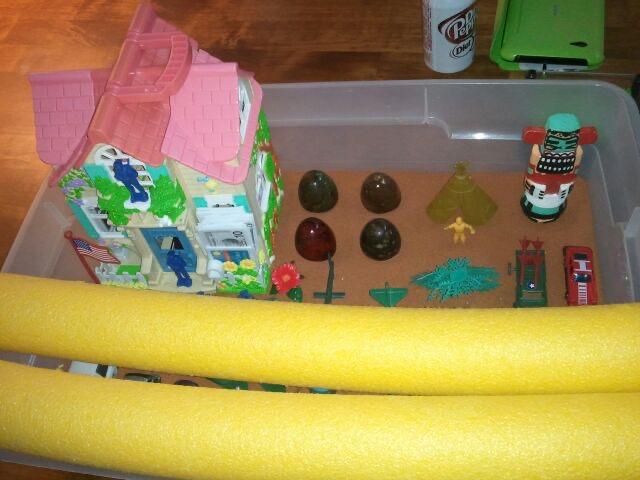
• The yellow “noodles” are the secret entrance.
• It is his house and it is very well guarded with men, planes, helicopters etc. What is inside is very “valuable”.
• The other items are there because he liked them.
• Make note of the money tucked in the front of the house.
• He has an adult in his life who is significant and is Native American – note the tee pee and totem pole.
• 50 SANDTRAY THERAPY DIRECTIVES:
• Build a tray about...For school age children:
• Your family
• Your friends at school
• Your typical day
• One side being the best part of your world/other side being the worst part of your world
• One side as when you feel happy/other side when you feel sad
• You favorite things
• The scariest thing in your world
• How you calm down when you are feeling upset
• What each of member of your family does most often
• What you want to do when you grow up
• For teenagers:
• A timeline of your life
• Your happiest memory
• The hurdles you face now
• Your ideal future
• What love looks like to you
• The most important things in your life
• Marriage/commitment
• Your daily routine
• What you see when you look in the mirror
• Your worst nightmare (either imagined or an actual dream)
• Courtesy of the Southern Sand Tray Institute – available on Facebook
Finger Painting
• For many children this can be a fun tactile sensation.
• Much freedom for expression
• Easily washes off as well
• Supply several colors
• Encourage the children to experiment such as use different colors and different movements
• You can make this more structured by having the child use cotton balls or other materials
• Have the child make a hand print and than turn it into something
• Be careful – for some children it is too stimulating. Because it is a less sophisticated medium, some children may regress when using it.
Sculpy or Plasticene
• Worry stones
• Free play
• Make faces
Dance and Movement
• This is very useful, as we will discuss, with children who have been abused or experienced some kind of trauma
• You can help children to loosen up in counseling by taking the lead and moving. You can move individually or together.
• This can do much for helping the child to be more comfortable as well as engaging with you.
Drama
• By playing other roles, children can better understand other people in their world or process feelings by acting in the manner they wish that person would act.
• Role playing also allows children to experiment in a safe way. They can try different reactions and behaviors.
• Easy examples:
• Rubbing the palate
• Squeezing the center of the palm
• Squeeze tip of each finger
• Inch worm down the finger
• Why? Stimulates serotonin and effects adrenals and reduce anxiety
Music
• Individuals, especially teens, identify a lot with music. The lyrics often express for them what they can not.
• Mood strongly impacts mood as well and we will gravitate to certain types of music depending upon how we feel and want to feel.
• Have children/teens bring in a song that describes who they are.
• You can use songs for them to describe how they feel.
• Use music as an intervention such as to build self-esteem.
Anxiety and Sleep
• Ways to reduce anxiety and improve sleep:
• Exercise
• Listen to relaxation music or recordings
• Practice relaxation techniques when facing a trigger or before sleep
• Pray/Meditate - think of a safe place
• Talk to someone
Avoid caffeine – eat something light before bed
• No liquids for two hours before bed
Read before bed or do something boring – avoid stimulating things like tv, video games, the computer etc..
• Sleep in your bed
• Take a walk – before bed this helps because it raises the body temperature and then it falls again
• Schedule a time to worry
• Use a white noise or sound machine
• Get into a routine with set bed time
Ways parents can help children learn to manage anxiety
• Personalize and externalize: Ask your child to give anxiety a name. Your child can draw pictures of anxiety, too. Then, help your child acknowledge anxiety when it rears up: ‘Is that spiky- toothed, purple Bobo telling you no one wants to play with you?’ Labeling and distancing anxiety can help your child learn to be the boss of it.
• Preview anxiety-provoking situations. Consider meeting camp counselors or touring new places ahead of time.
• Model confidence: Children are emotional Geiger counters. They register anxiety radiating from parents. Try to be mindful of what you model through words and body language. Work on tempering overanxious reactions when appropriate.
• Narrate their world: “Children are coding the world. Particularly through early childhood their brains are just sponges, taking everything in,” says Dr. Potter. “We can help them with the narrative they’re constructing: ‘Is the world a safe place or a dangerous place where I have to be on guard all the time?’”
• Allow distress: Avoiding distressing situations invites anxiety to ease temporarily, only to pop up elsewhere. Rational explanations won’t work, either. The whirring emotional center of the brain known as the limbic system requires time and tools to calm down enough to let the thinking (cognitive) center of the brain come back online. Instead, try distress tolerance tools: one child might splash her face with cold water, another might charge up and down stairs to blow off anxious energy, or tense and relax her muscles, or distract herself by looking around to find every color in the rainbow.
• Practice exposure: Gradual exposure helps rewire an anxious brain and shows a child he can survive anxious moments. Let’s say your child is anxious about talking in public, ducking his head and squirming if addressed. Pick a pleasant, slow-paced restaurant for a fun weekly date. Then coach your child to take charge of ordering foods he likes in small steps. At first, he might whisper the order to you and you’ll relay it to the waitress. Next, he might order just his drink or dessert, and finally a full meal as distress tolerance and confidence grows.
Managing Symptoms: Staying Healthy
• Being healthy is important for all children, and can be especially important for children with depression or anxiety. In addition to getting the right treatment, leading a healthy lifestyle can play a role in managing symptoms of depression or anxiety. Here are some healthy behaviors that may help:
• Having a healthy eating plan centered on fruits, vegetables, whole grains, legumes (beans, peas, and lentils), lean protein sources, and nuts and seeds
• Participating in physical activity each day based on age
• Getting the recommended amount of sleep each night based on age
• Practicing mindfulness or relaxation techniques
1.Bitsko RH, Claussen AH, Lichtstein J, Black LJ, Everett Jones S, Danielson MD, Hoenig JM, Davis Jack SP, Brody DJ, Gyawali S, Maenner MM, Warner M, Holland KM, Perou R, Crosby AE, Blumberg SJ, Avenevoli S, Kaminski JW, Ghandour RM. Surveillance of Children’s Mental Health – United States, 2013 – 2019 MMWR, 2022 / 71(Suppl-2);1–42.
2.Bitsko RH, Holbrook JR, Ghandour RM, Blumberg SJ, Visser SN, Perou R, Walkup J. Epidemiology and impact of healthcare provider-diagnosed anxiety and depression among U.S. children. Journal of Developmental and Behavioral Pediatrics. 2018;39:395-403.
Tips for Parents
• Important to tell children it is okay to be afraid
• Talk to your child – what are they worried about
• Help the child face fears/worries gradually
• Talk your child through the situation
• Do not avoid fears – also encourage facing the fears
• Set realistic goals so as to not overwhelm the child.
• Let them tell you the steps that they are ready to take – than they will feel some control
• (Chanksy, 2004)
Symptom Checker - Child Mind Institute
• Here’s how it works:
• You indicate the behaviors that are making you concerned about your child by answering a series of questions. The Symptom Checker analyzes your answers to give you a list of psychiatric or learning disorders that are associated with those symptoms.
• Since individual symptoms can reflect more than one disorder, this tool will give you a range of possibilities and guide you toward next steps. This tool cannot diagnose your child, but it can help you inform yourself about possible diagnoses and will offer information and articles to help you learn about them, to facilitate a conversation with a professional.
So what about you?
• Teachers also deal with anxiety.
• Whether you are a beginning teacher or a long-term veteran, this has probably been the most challenging year of your career. Regardless of if you are teaching in person, virtually, or in a hybrid model of some sort, you are expending every ounce of your energy trying to reach your students. Many of us have been so caught up in the madness that we have forgotten the most important factor: taking care of ourselves. These teacher guided meditations can be done anywhere and are perfect for when you just need to breathe.
3. 10 Minute Guided Meditation to Start the Day
• https://youtu.be/0BgQoaC5vnA
• 1. 10 Minute Guided Meditation for Beginners
• https://youtu.be/U9YKY7fdwyg
• This is a great video for anyone, especially if you are new to meditation. Relax and breathe.
• 2. 10 Minute Guided Meditation for Anxiety
• https://youtu.be/O-6f5wQXSu8
• Try this meditation anytime you are feeling anxious to put your mind at ease. Breathe. Just breathe.
• This is one of our favorite teacher guided meditations. Try it first thing in the morning to bring positive vibes throughout your day! Good, good, good, good vibrations.
• 4. Calming Meditation with Affirmations
• https://youtu.be/axVXoyB-_2I
• Kassandra Reinhardt of Yoga With Kassandra will soothe your soul with these calming affirmations. Check out her YouTube channel for more gentle meditations and a plethora of yoga classes for beginner, intermediate, and advanced yogis. Namaste.
• 5. 10 Minute Guided Meditation for Inner Peace
• https://youtu.be/d4S4twjeWTs
• Adrienne Mishler of Yoga with Adrienne walks you through this peaceful meditation to help you catch your breath. Her YouTube channel is filled with mediations and yoga classes for yogis of all levels. Catch your breath with her and her adorable dog, Benji!
• 6. Deepak Chopra 10 Minute Guided Meditation
• https://youtu.be/BiYWp6I-RcE
• World-famous, spiritual guru Deepak Chopra will help you catch your breath with this meditation when you are feeling uneasy. In addition, check out his books and other videos for advice on achieving a more peaceful and balanced life.
• 7. A Mindful, Self Soothing, Guided Meditation https://youtu.be/Xl_B45DpMLU
• Join Tamara Levitt to wash your worries away in just 10 minutes. If you enjoy this meditation, be sure to check out more from Tamara through her website and popular app, Calm.
• 8. Feel Amazing in 10 Minutes
• https://youtu.be/hADTMwySEng
• Change your whole outlook in just 10 minutes with this amazing meditation. Breathe in, breathe out.
• 9. A Grounding Guided Meditation
• https://youtu.be/hhRS3zly8kw
• Join the Mindful Movement to ground yourself while chasing nervous feelings away. Zen starts now!
• 10. Feel the Positive Energy from Gratitude
• https://youtu.be/j5v6-V0x90A
• This meditation is a great pick me up, focusing on self-love, acceptance, and forgiveness. Breathe the blues away!
• 11. Focus on Self Improvement Guided Meditation
• https://youtu.be/fYSh2Jklr8I
• This meditation is a great pick me up, focusing on self-love, acceptance, and forgiveness. Breathe the blues away!
• 12. Let it All Go with This Guided Meditation
• https://youtu.be/syx3a1_LeFo
• Forget all your troubles with this guided meditation. Picture ocean waves rolling in and out as you let go.
• 13. Cleanse Your Chakras in 10 Minutes
• https://youtu.be/o89px3RWFS8
• Chakras are the seven energy points in the body, from the crown of the head to the base of the spine. They correspond to the nerves, organs, and other body parts. This meditation will help cleanse and align the chakras for peace and calm.
• 14. Take a Time Out From Stress
• https://youtu.be/7KXnALvPIW8
• Visualize white sand beaches and ocean waves as you catch your breath and take time out from stress.
• 15. Remove Blockages and Negative Energies
• https://youtu.be/fTrAWsufRXE
• Are you feeling stuck, depressed, or in a rut? Master Sri Akarshana will help you turn those negative thoughts into positive ones. Happiness starts now!
• 16. Calm Down and Banish Stress With This Guided Meditation
• https://youtu.be/EAwNUaKy_zE
• Feeling frazzled or stressed is not enjoyable. Calm down and banish negative feelings with this 10-minute meditation from the Honest Guys.
• 17. Positive Affirmations to End Your Day
• https://youtu.be/6y4PVjjetUw
We have all had one of those days where it feels like nothing is going right. This evening meditation is perfect for when you need to shut off your brain and reassure yourself that everything’s gonna be alright.
• 18. Sleep Well with This Guided Meditation
• https://youtu.be/bG3AcN-XOrw
• Boho Beautiful leads this 10-minute meditation to help you sleep soundly. Start counting those sheep before your head even hits the pillow.
• 19. Evening Guided Meditation from Goodful
• https://youtu.be/aEqlQvczMJQ
• Get cozy and ready for a night of deep sleep as you take deep breaths with this 10-minute guided meditation from Goodful.
20 Terrific 10 Minute Teacher Guided Meditations (weareteachers.com)
• When kids are anxious, it’s natural to want to help them feel better. But by trying to protect kids from the things that upset them, you can accidentally make anxiety worse. The best way to help kids overcome anxiety is to teach them to deal with anxiety as it comes up. With practice, they will be less anxious.
• When a child gets upset in an uncomfortable situation and their parents take them out of it, they learn that getting upset is a good way to cope. Instead, it’s helpful for parents to let kids know that they’re going to be okay, even if they’re scared. You can’t promise your child that nothing bad will happen. But you can express confidence that they can face their fears and feel less afraid over time.
• You can show your child empathy without agreeing with their fears. For example, you might say: “I know you’re scared to get this shot. It’s okay to be scared. You can get through this, and I’m going to help you.” It’s usually helpful to avoid leading questions (“Are you worried about the test tomorrow?”). Instead, ask open questions (“How do you feel about the test tomorrow?”). You can use your tone of voice and body language to show your child that you’re calm, which can help them stay calm too.
• Parents can also help by keeping kids distracted before something that might be upsetting, like a doctor’s appointment. Sometimes it helps to talk with your child about what might happen if their fears came true. What would they do? Who would they ask for help? Having a plan can calm anxiety.
• Finally, parents can model healthy ways of handling anxiety. Parents get anxious too, and that’s okay! The goal is to show your child that anxiety is normal and that it doesn’t have to be a big deal.
• When children are chronically anxious, even the most well-meaning parents, not wanting a child to suffer, can actually make the youngster’s anxiety worse. It happens when parents try to protect kids from their fears. Here are pointers for helping children escape the cycle of anxiety.
• 1. The goal isn’t to eliminate anxiety, but to help a child manage it.
• None of us wants to see a child unhappy, but the best way to help kids overcome anxiety isn’t to try to remove stressors that trigger it. It’s to help them learn to tolerate their anxiety and function as well as they can, even when they’re anxious. And as a byproduct of that, the anxiety will decrease over time.
• 2. Don’t avoid things just because they make a child anxious.
• Helping children avoid the things they are afraid of will make them feel better in the short term, but it reinforces the anxiety over the long run. Let’s say a child in an uncomfortable situation gets upset and starts to cry not to be manipulative, but just because that’s how they feel. If their parents whisk them out of there, or remove the thing they’re afraid of, the child has learned that coping mechanism. And that cycle has the potential to repeat itself.
• 3. Express positive but realistic expectations.
• You can’t promise a child that their fears are unrealistic that they won’t fail a test, that they’ll have fun ice skating, or that another child won’t laugh at them during show & tell. But you can express confidence that they’re going to be okay, that they will be able to manage it. And you can let them know that as they face those fears, the anxiety level will drop over time. This gives them confidence that your expectations are realistic, and that you’re not going to ask them to do something they can’t handle.
• 4. Respect their feelings, but don’t empower them.
• It’s important to understand that validation doesn’t always mean agreement. So if a child is terrified about going to the doctor because they’re due for a shot, you don’t want to belittle those fears, but you also don’t want to amplify them. You want to listen and be empathetic, help them understand what they’re anxious about, and encourage them to feel that they can face their fears. The message you want to send is, “I know you’re scared, and that’s okay, and I’m here, and I’m going to help you get through this.”
• 5. Don’t ask leading questions.
• Encourage your child to talk about their feelings, but try not to ask leading questions “Are you anxious about the big test? Are you worried about the science fair?” To avoid feeding the cycle of anxiety, just ask open-ended questions: “How are you feeling about the science fair?”
• 6. Don’t reinforce the child’s fears.
• What you don’t want to do is be saying, with your tone of voice or body language: “Maybe this is something that you should be afraid of.” Let’s say a child has had a negative experience with a dog. Next time they’re around a dog, you might be anxious about how they will respond, and you might unintentionally send a message that they should, indeed, be worried.
• 7. Encourage the child to tolerate their anxiety.
• Let your child know that you appreciate the work it takes to tolerate anxiety in order to do what they want or need to do. It’s really encouraging them to engage in life and to let the anxiety take its natural curve. We call it the “habituation curve.” That means that it will drop over time as he continues to have contact with the stressor. It might not drop to zero, it might not drop as quickly as you would like, but that’s how we get over our fears.
• 8. Try to keep the anticipatory period short.
• When we’re afraid of something, the hardest time is really before we do it. So another rule of thumb for parents is to really try to eliminate or reduce the anticipatory period. If a child is nervous about going to a doctor’s appointment, you don’t want to launch into a discussion about it two hours before you go; that’s likely to get your child more keyed up. So just try to shorten that period to a minimum.
• 9. Think things through with the child.
• Sometimes it helps to talk through what would happen if a child’s fear came true how would they handle it? A child who’s anxious about separating from their parents might worry about what would happen if a parent didn’t come to pick them up. So we talk about that. If your mom doesn’t come at the end of soccer practice, what would you do? “Well I would tell the coach my mom’s not here.” And what do you think the coach would do? “Well he would call my mom. Or he would wait with me.” A child who’s afraid that a stranger might be sent to pick them up can have a code word from their parents that anyone they sent would know. For some kids, having a plan can reduce the uncertainty in a healthy, effective way.
• 10. Try to model healthy ways of handling anxiety.
• There are multiple ways you can help kids handle anxiety by letting them see how you cope with anxiety yourself. Kids are perceptive, and they’re going to take it in if you keep complaining on the phone to a friend that you can’t handle the stress or the anxiety. I’m not saying to pretend that you don’t have stress and anxiety, but let kids hear or see you managing it calmly, tolerating it, feeling good about getting through it.
From Child Mind Institute
• THANK YOU VERY MUCH!
• I truly hope that you have found this presentation informative and useful. If I can be of any further assistance, please do not hesitate to contact me.
• Sincerely,
• Dr. Christine Dargon
• 603-321-7284
• docborg98@yahoo.com
• On Linkedin and Facebook:
• Dr. Christine Frydenborg Dargon
• www.christinefrydenborgdargon.com
RESOURCES
• 1. Building Strong Classroom Community
RESOURCES
• 2. On My Walk Journal pages
• 3. Character Role Play Cards (Character Role Playing Cards Worksheets (worksheetplace.com))
• 4. Third Grade writing prompts
• 5. Community Building Conversation Starter Cards. (CommunityBuilding-Activity_Printable_Discussion_Starters.pdf)
References
1. Wilkins NJ, Verlenden JV, Szucs LE, Johns M. (2022) Classroom management and facilitation approaches that promote school connectedness. Journal of School Health doi: https://doi.org/10.1111/josh.13279
2. Steiner RJ, Sheremenko G, Lesesne C, Dittus PJ, Sieving RE, Ethier KA. Adolescent connectedness and adult health outcomes. Pediatrics. 2019;144(1).
3. Marraccini ME, Brier ZM. School connectedness and suicidal thoughts and behaviors: A systematic meta-analysis. School Psychology Quarterly. 2017;32(1):5.
4. Niehaus K, Rudasill KM, Rakes CR. A longitudinal study of school connectedness and academic outcomes across sixth grade. Journal of School Psychology. 2012;50(4):443-460.
5. Carter M, McGee R, Taylor B, Williams S. Health outcomes in adolescence: Associations with family, friends and school engagement. Journal of adolescence. 2007;30(1):51-62.
6. Griffiths A-J, Lilles E, Furlong MJ, Sidhwa J. The relations of adolescent student engagement with troubling and high-risk behaviors Handbook of research on student engagement: Springer; 2012. p. 563-584.
7. Lei H, Cui Y, Zhou W. Relationships between student engagement and academic achievement: A meta-analysis. Social Behavior and Personality: an international journal 2018;46(3):517-528.
1.Evertson CM, Weinstein CS. Classroom management as a field of inquiry. Handbook of classroom management: Research, practice, and contemporary issues. 2006;3(1):16.
2.Hawkins JD, Guo J, Hill KG, Battin-Pearson S, Abbott RD. Long-term effects of the Seattle Social Development Intervention on school bonding trajectories. Applied developmental science. 2001;5(4):225-236.
3.Gest SD, Madill RA, Zadzora KM, Miller AM, Rodkin PC. Teacher management of elementary classroom social dynamics: Associations with changes in student adjustment. Journal of Emotional and Behavioral Disorders 2014;22(2):107-118.
4.Cappella E, Hamre BK, Kim HY, Henry DB, Frazier SL, Atkins MS, et al. Teacher consultation and coaching within mental health practice: Classroom and child effects in urban elementary schools. Journal of consulting and clinical psychology. 2012;80(4):597.
5.Kim HY, Cappella E. Mapping the social world of classrooms: A multi-level, multi-reporter approach to social processes and behavioral engagement. American journal of community psychology. 2016;57(1-2):20-35.
6.Kiefer SM, Pennington S. Associations of teacher autonomy support and structure with young adolescents’ motivation, engagement, belonging, and achievement. Middle grades research journal. 2017;11(1).
